#metallic small tile backsplash
Explore tagged Tumblr posts
Photo
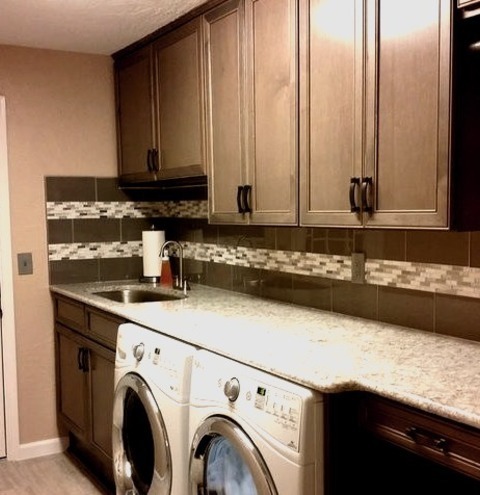
Laundry Tampa Inspiration for a mid-sized transitional single-wall porcelain tile and beige floor utility room remodel with an undermount sink, medium tone wood cabinets, a side-by-side washer/dryer, recessed-panel cabinets, granite countertops and beige walls
#dover grey door#metallic small tile backsplash#beige walls white trimming#bridgewood american value cabinets#glass/metal mosaic backsplash#multiuse
0 notes
Text
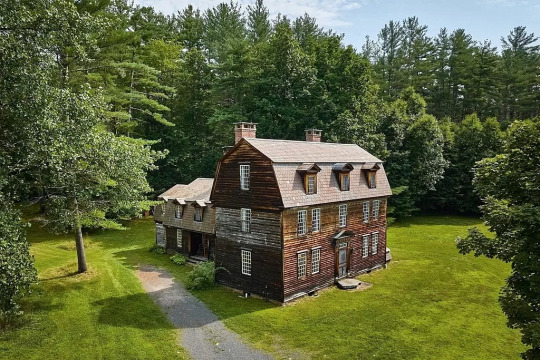
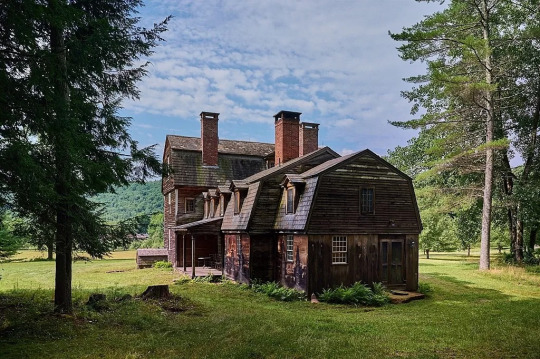
What a fine historic home. It's not my style, but I have to appreciate the craftsmanship and how, over the course of 20 yrs., they meticulously restored the Gambrel Colonial. It's now a museum quality reproduction crafted by master carpenters and architectural woodworkers that used authentic old world techniques. The 1900 home in Charlemont, MA has 6bds, 5ba, 4,473 sq ft, $2.1m.
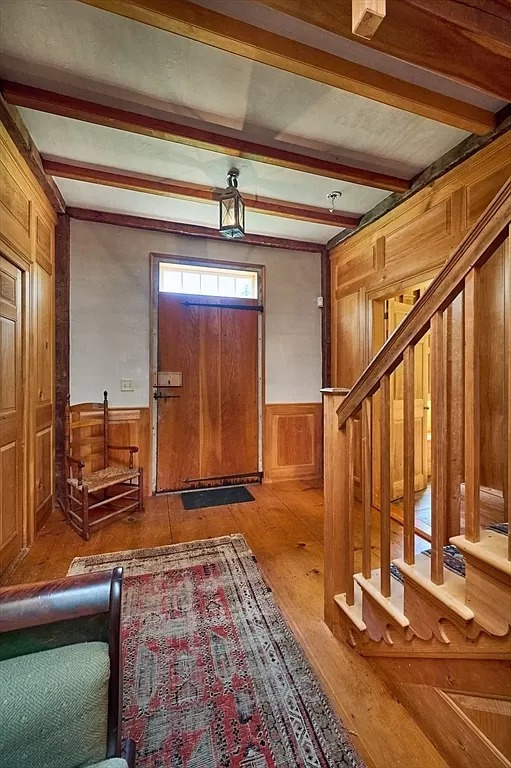
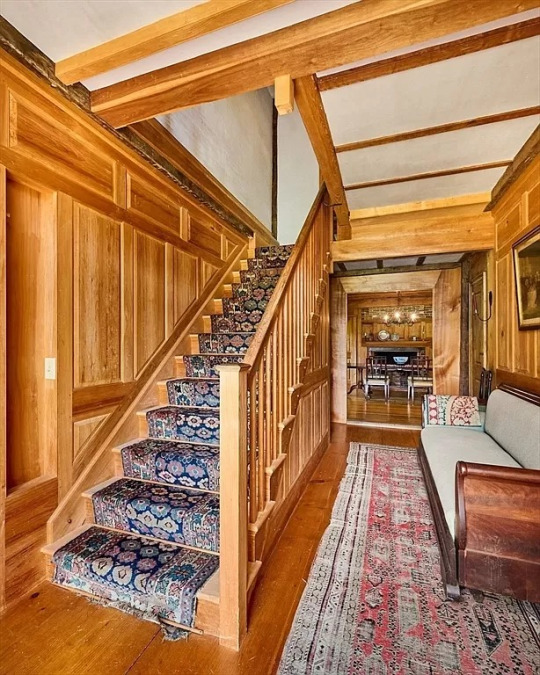
The entrance hall has wide-plank knotty pine floors, wainscoting and wood paneling. The new woods give it a much lighter look.
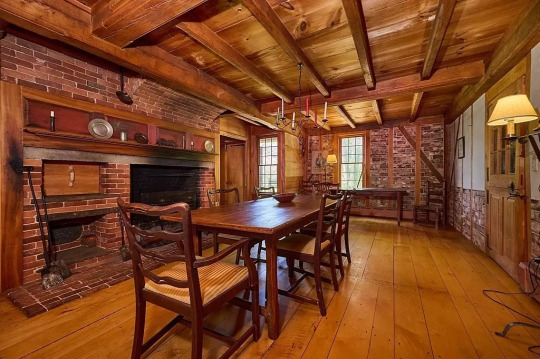
If you're going to renovate an historic home, this is the way to do it.
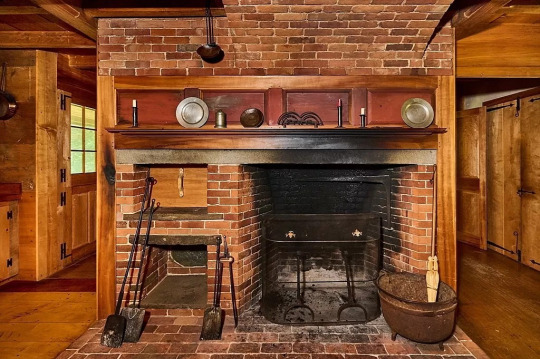
Can you picture how they cooked in this hearth? Look at the oven on the left.
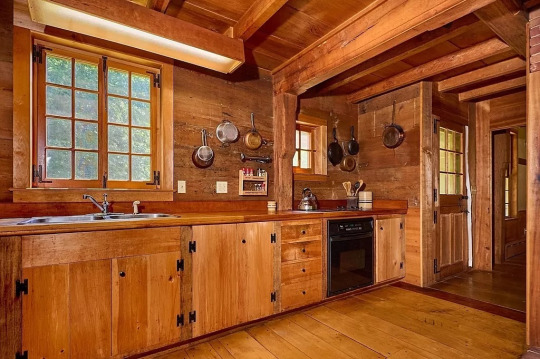
Love that they didn't use tile or quartz on the counter and backsplash. Originally, they would've been made of wood. Look at the beautiful large beam. Simple metal pots and pans would've hung on the wall just like these.
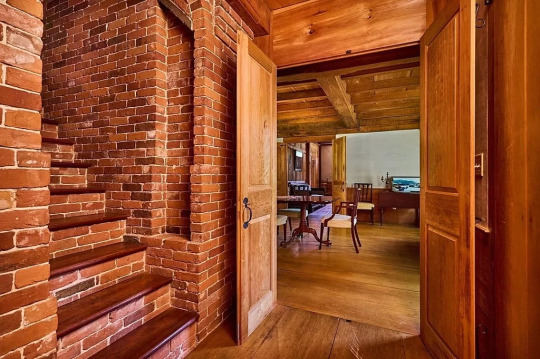
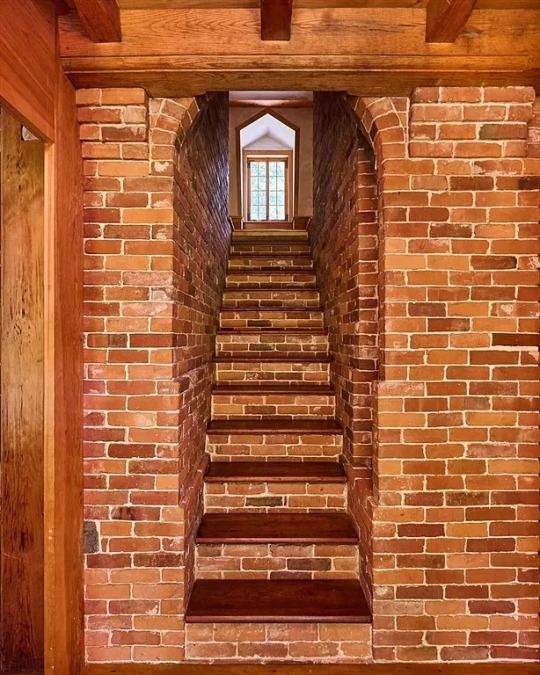
I've never seen stairs like this, actually inside a brick wall.
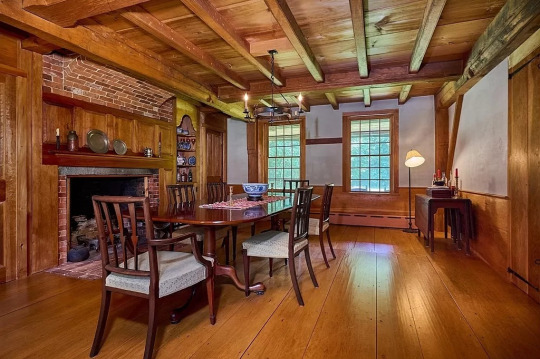
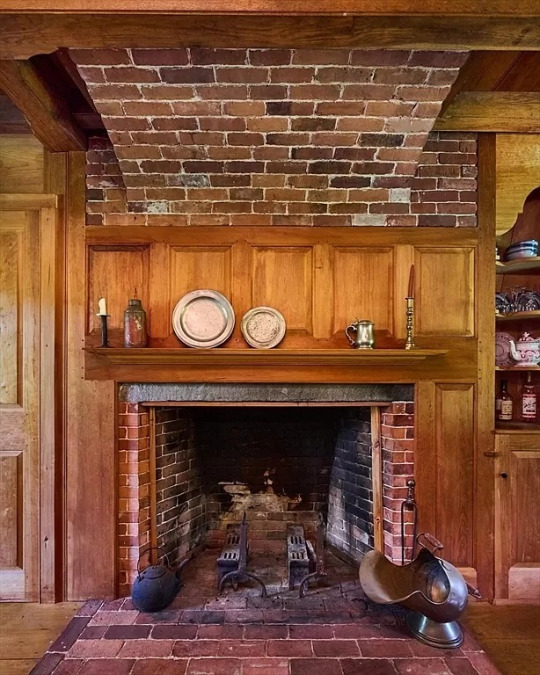
The dining room has a fireplace with a deep firebox and a wall of built-in storage.
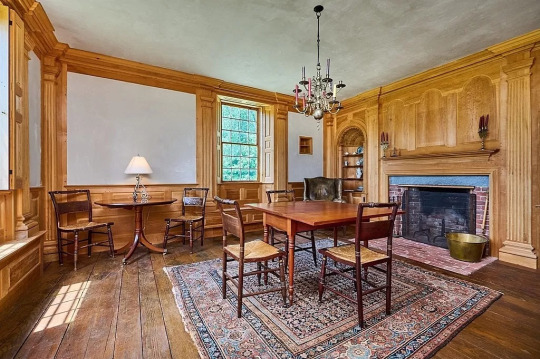
This room has lovely carved columns around the windows, plus window seats and crown molding. The feature wall also has lovely carved features as well as beautifully arched recessed shelving.
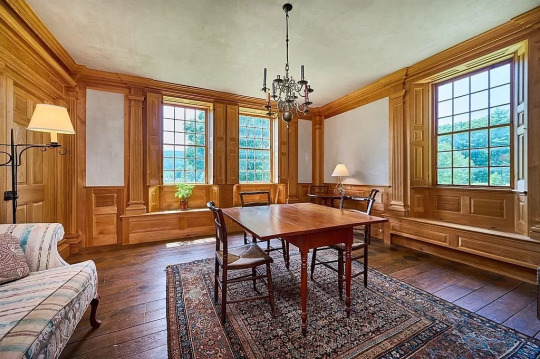
The chandelier looks like it's not electrified. Just authentic pewter and candles. I can't get over how they reproduced all of this. Typically, pine was used on the floors and these are knotty pine. For the walls, etc., they used white pine, oak, and maple.
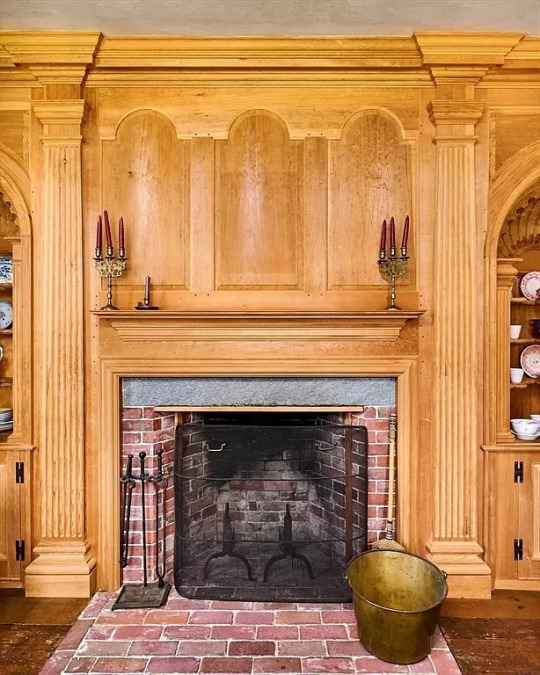
Some of the wood looks like it may have been restored. I can't be sure, but it looks like white pine.
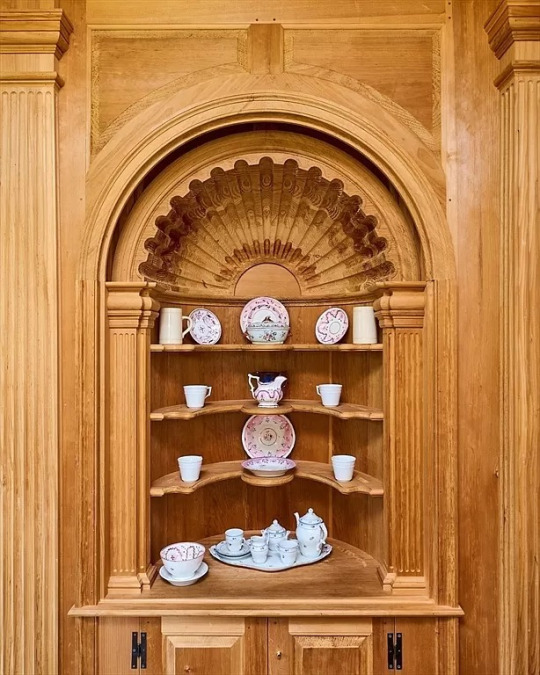
Such exquisite work.
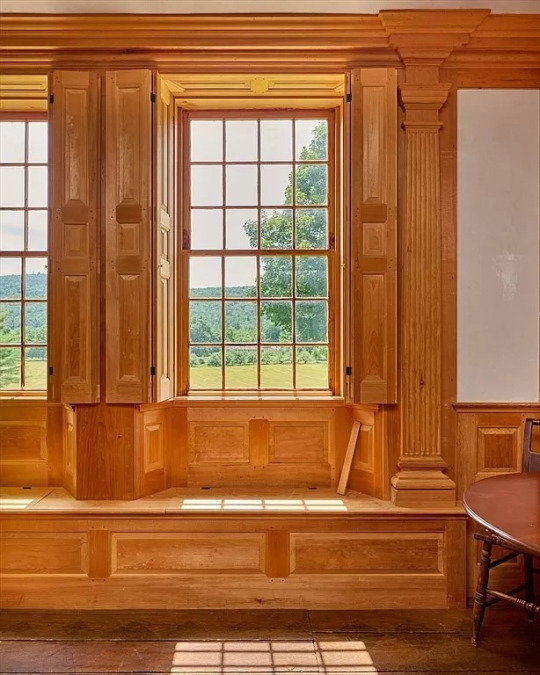
Deep window seats and working shutters.
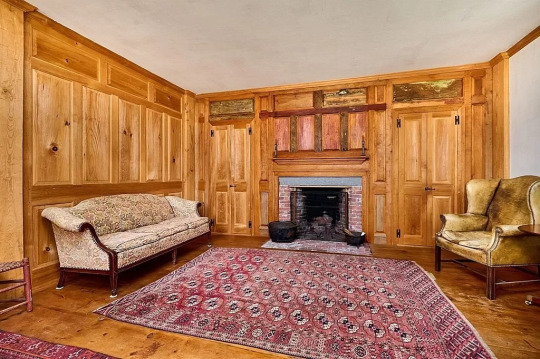
In the living room, you can see the discolored wood above the fireplace is definitely restored and original.
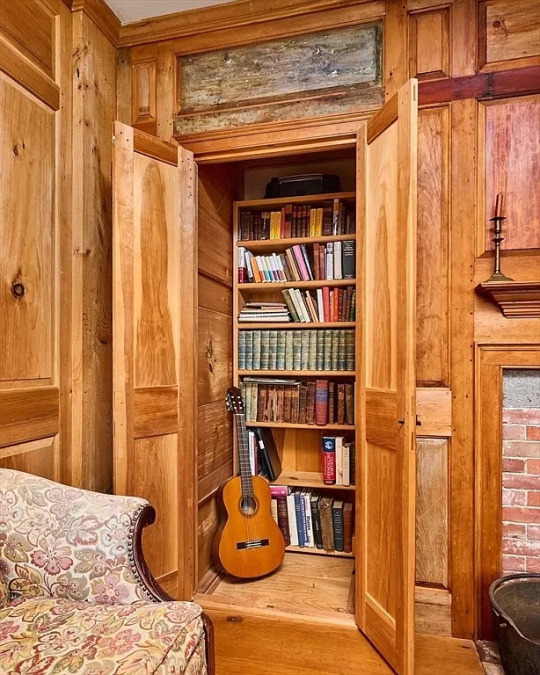
And, look at the deep closets with inset bookshelves.
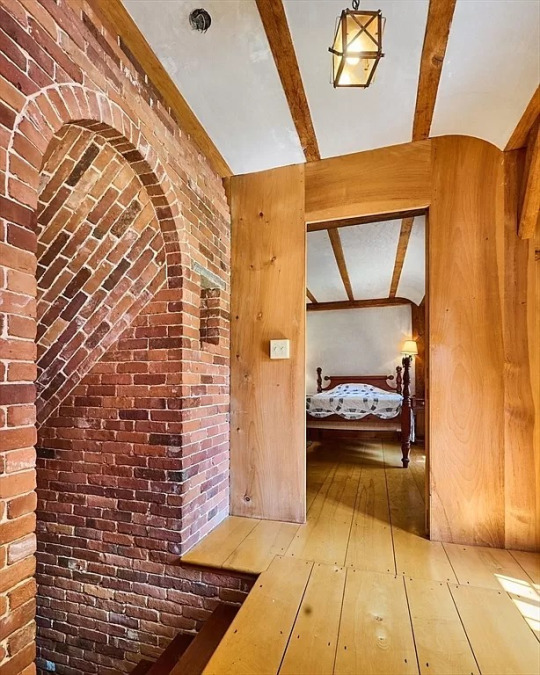
Look at the pitch of the stair well. There's even a small niche in the wall. No hand rails, though. Yikes.
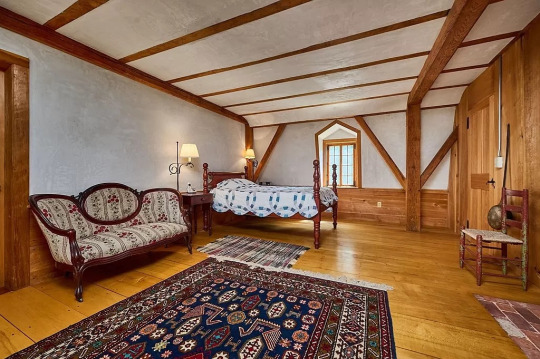
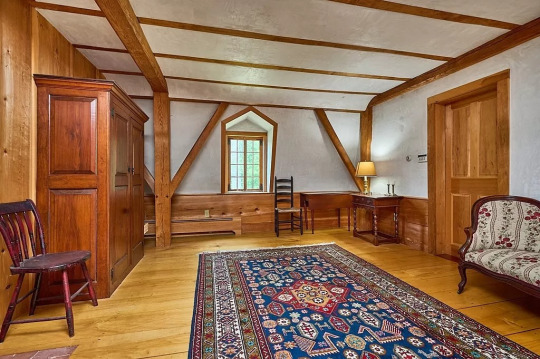
This bedroom is huge.
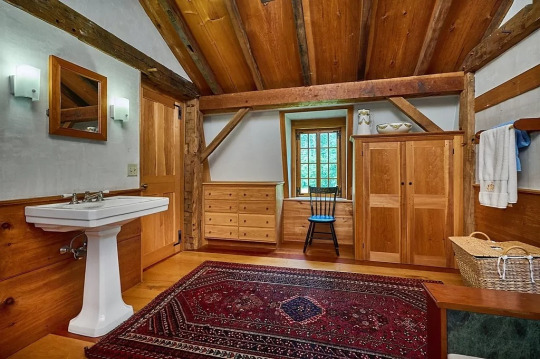
The bathroom is also large and has wonderful built-in storage furniture.
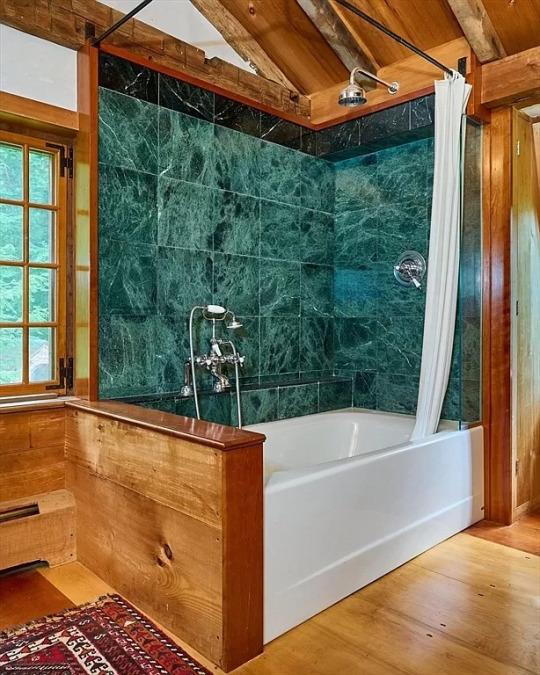
I'm disappointed in the choice of tub, though. They do have beautifully authentic reproduction plumbing fixtures.
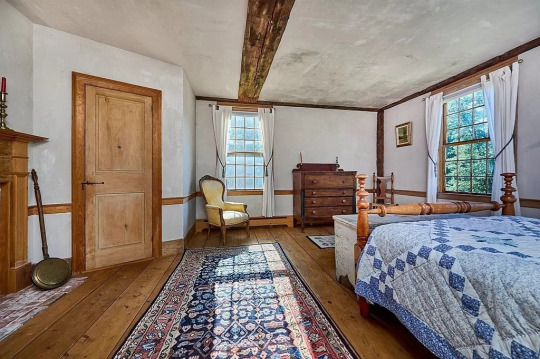
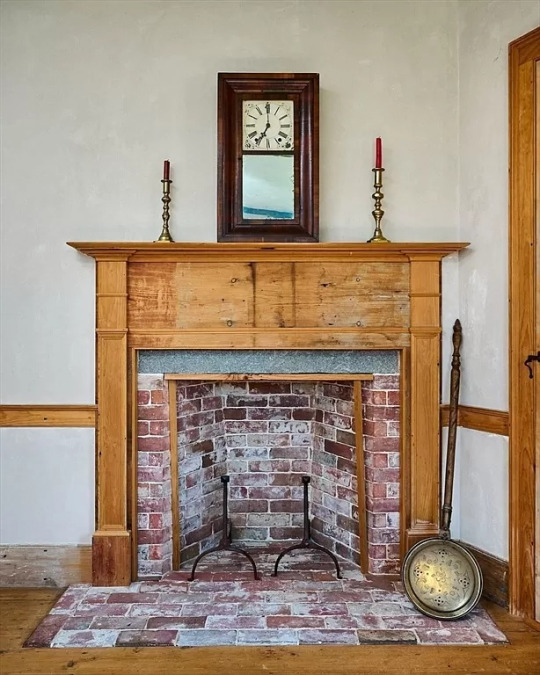
This secondary bd. is also very large. Cute utilitarian fireplace.
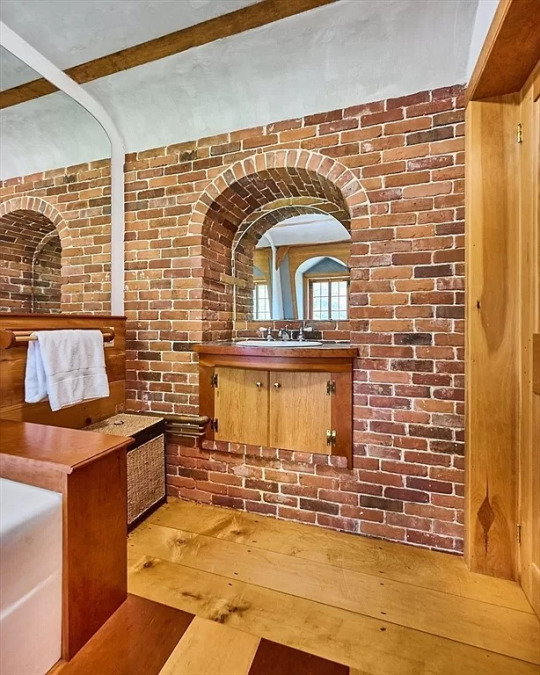
I like the way they recessed the sink in the brick wall.
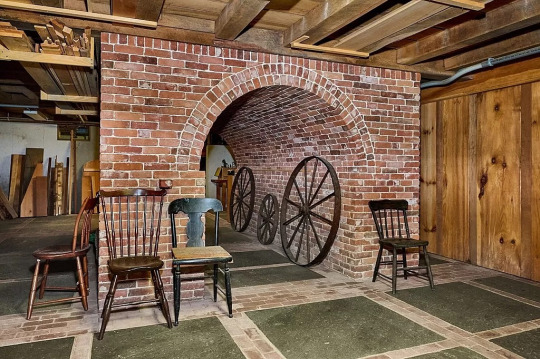
This brick structure in the basement is wonderful. It's like a tunnel.
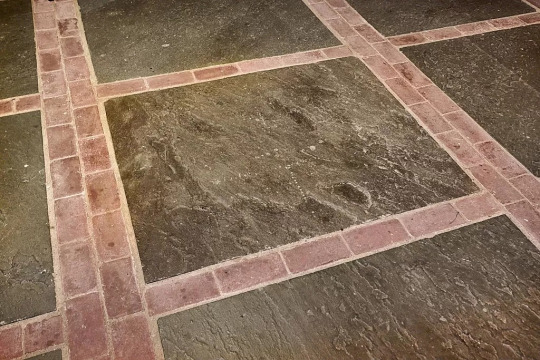
They did a slate and brick floor down here.
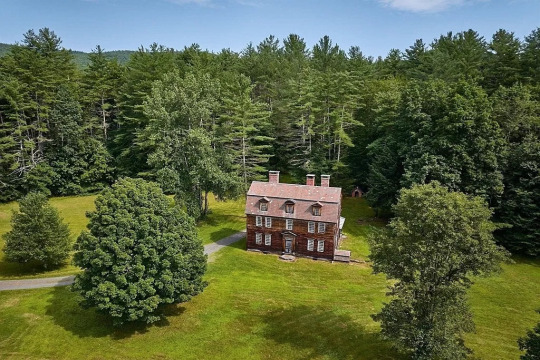
The home is in a lovely green setting.
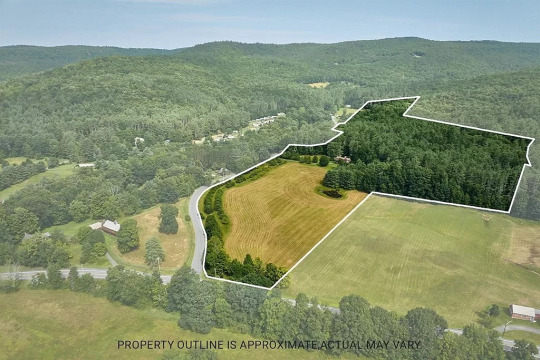
53.63 acres of land. That's a lot of land!
https://www.zillow.com/homedetails/24-W-Oxbow-Rd-Charlemont-MA-01339/56976309_zpid/
320 notes
·
View notes
Text
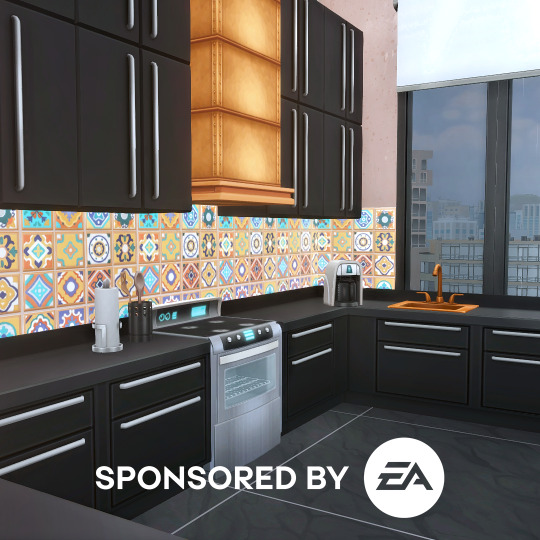
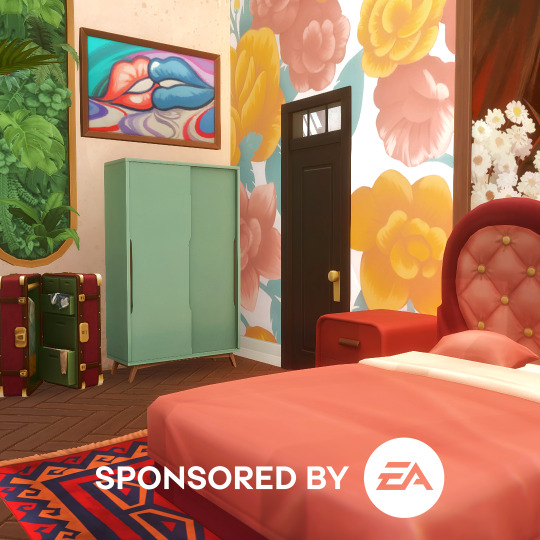
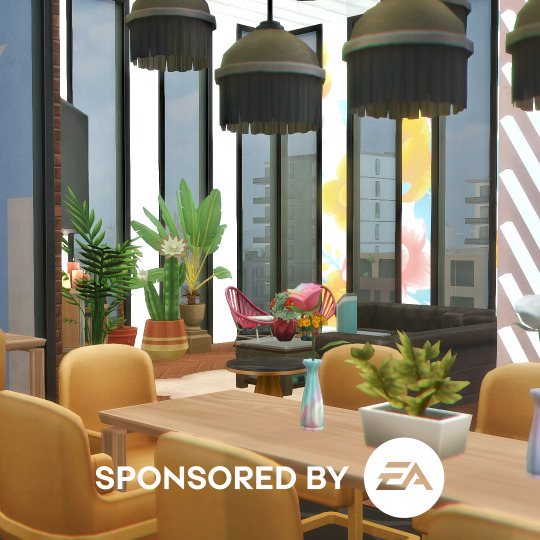
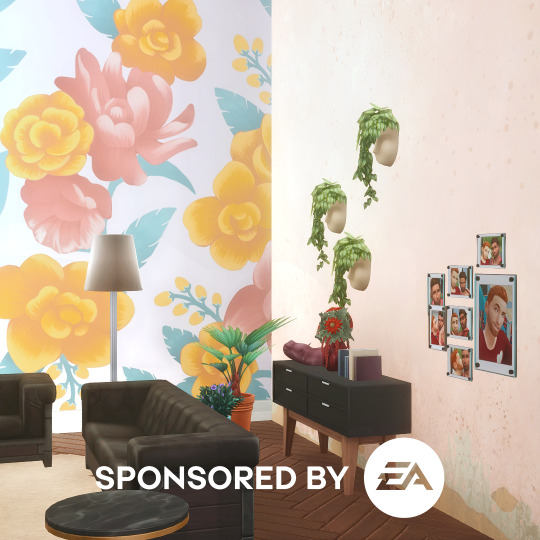
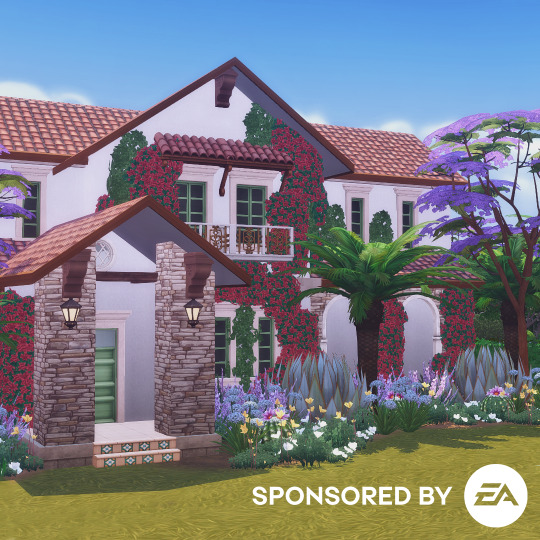
Lovestruck: Build/Buy
I like build/buy for the vision, but it's eclectic so if you want to use one of the specific styles, you don't end up with enough items to pull it together. For the most part it works well with Basegame items, but those are starting to show their age when used with the newer content from the latest packs. The tile backsplash is a wall object and great to have that flexibility, and I really love the plaster and flower mural walls. There is a ceiling beam item, but I removed it after using initially as I play top down and it kept getting in my way.
Build is a little confusing for me. The metal frame windows just seem too small for me, and I just couldn't think how to use them. Again, most items are made just for short wall height so if you like building with Medium or even tall you really only have the stone surround items to work with. They are by far the best, but I wish it had more options despite having curved variants which I probably won't use.
I definitely see myself making a build and buy mode addon for this pack to satisfy my own needs in the future, but I will have to play with the items more to see where they are lacking, and if I can fill the gaps.
279 notes
·
View notes
Text
Which interior style is usually the cheapest to implement: choosing from the 4 main ones
Many homeowners dream of a stylish interior, yet finances often guide their decisions. A well-chosen design can refresh a home and protect the budget.
This article reviews four popular interior styles and determines which one offers the most cost-effective approach.
Renovation expenses can surge if you pick the wrong approach. Selecting a practical style truly saves money.
Industrial Style

Industrial style features exposed brick, metal fixtures, and reclaimed wood. These elements often come from old warehouses. A Brooklyn loft with original brick walls, visible pipes, and secondhand metal chairs is a real example. Vintage lighting can raise costs, yet leaving surfaces untouched may lower labor expenses. Some homeowners incorporate large factory-style windows to bring in natural light and repurpose old lockers or metal racks as storage. These tactics often reinforce the raw appeal and keep spending within reason.
Scandinavian Style
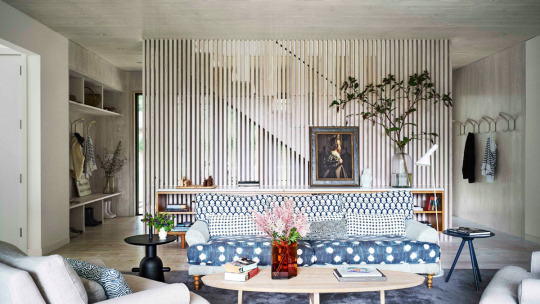
Scandinavian design centers on natural light, simple lines, and functional furniture. A small apartment in Stockholm with white floors, streamlined sofas, and birch tables illustrates this look. Neutral-toned rugs and practical storage units maintain a lower budget. Decorative blankets or houseplants add warmth without overspending. Homes in cities like Oslo or Copenhagen exemplify how clean layouts, subtle textiles, and small decorative accents can form a restful atmosphere. Many people appreciate the bright color palette that reduces the need for expensive lighting solutions.
Minimalist Style

Minimalist interiors showcase an open layout, limited furniture, and sleek surfaces. A Tokyo studio with nearly empty walls, a single sofa, and a low-profile bed shows this concept. Premium materials like smooth concrete can boost expenses, but DIY solutions and reused pieces are budget-friendly. Plywood shelves or basic white cabinets often balance costs. Large mirrors can amplify available light and reduce the number of lamps you might need. This approach suits individuals who value a clutter-free life and prefer simplicity over multiple accessories.
Rustic Style

Rustic style prioritizes rough-hewn wood or stone. A country cottage near the Alps might feature thick beams, hand-carved chairs, and a stone fireplace. High-quality timber raises prices, yet salvaged barn doors cut spending. Specialized carpentry can add cost. Some rural bed-and-breakfasts demonstrate how natural fabrics like linen curtains and wool rugs integrate well with rough wood surfaces. The overall result is cozy, but material sourcing may require patience if you want authentic pieces.
Costs, Examples, And Practical Lists
Costs hinge on materials, labor, and project size. Many people choose industrial or minimalist as affordable options, though local resources affect expenses. One homeowner in New England converted an abandoned warehouse into a chic industrial loft by acquiring secondhand fixtures at auction. Another individual in rural France renovated a barn in a rustic manner by salvaging aged planks from a nearby demolition site. Each approach balanced creativity with financial control.
Here is a list of factors:
Budget. Always confirm how much you want to spend.
Material sources. Pick local suppliers or secondhand items.
Skilled labor. Check availability of builders or carpenters.
Personal taste. Select a style that fits daily life.
These points guide interior planning. Evaluating local prices and existing spaces helps reveal the best style.
When trimming costs, consider these:
reuse older furniture;
repurpose leftover materials;
compare prices from different shops.
That approach can spark creative solutions, such as using a vintage door as a coffee table or leftover tiles as a backsplash accent.
Cheaper Style Verdict
Minimalist design usually ranks as the least expensive. It needs fewer furnishings, and many parts can be built with simple tools. Scandinavian can be similarly thrifty with basic items. Industrial becomes cheap with abundant reclaimed materials, and rustic can be affordable if old wood is on hand.
Renovation alone might seem tempting, but it's not an easy thing to do. An experienced team knows color schemes and structural nuances. E&A Partners offers professional guidance. Another option might be Johnson Interiors, which coordinates labor and furniture.
Points Worth Remembering
Minimalist style often ranks as the most economical choice. Industrial demands caution with sourcing, Scandinavian emphasizes light colors, and rustic relies on reclaimed treasures. Local resources, DIY tasks, and expert insights strongly influence final bills.
Practical Takeaways For Homeowners
Each style can look appealing without draining your savings. Minimalism typically stands out for lower costs, but other styles remain viable with smart planning. It is wise to review local conditions and pick labor methods that fit your goals. Professional designers can simplify decisions and boost confidence.
2 notes
·
View notes
Text
Making a Statement: Bold Design Elements for St Kilda Bathrooms

St Kilda, known for its vibrant culture, coastal beauty, and eclectic mix of modern and heritage homes, is the perfect place to experiment with bold design elements in bathroom renovations. When done right, daring design choices can transform a bathroom from a basic necessity into a luxurious sanctuary. Whether you live in a charming Victorian terrace or a contemporary apartment, your bathroom's a place for boldness.
In this article, we'll explore bold design elements that can elevate the look and feel of your St Kilda bathroom. From daring colours to statement tiles and luxurious fixtures, these tips will inspire you to create a bathroom that's as unique as your style.
1. Vibrant Color Schemes
Bold Color Palettes for Maximum Impact
Gone are the days when bathrooms were restricted to neutral tones. Now, bold colours are making waves in bathroom design. Whether you prefer rich, dramatic hues or vibrant pops of colour, incorporating bold shades can infuse your bathroom with personality and excitement.
Deep Blues and Greens: These colours evoke calm and luxury, making them ideal for creating a spa-like atmosphere. Navy blue, emerald green, and teal are popular for bathroom walls, accent tiles, or cabinetry. These deep tones contrast beautifully with white or light-coloured fixtures.
Contrasting Accents: For a more subtle approach, consider using bold colours as accent features. Bright yellow towels, a red statement mirror, or a black and white geometric rug can add energy to a minimalist space without overwhelming it.
Bold Dark Tones: Dark, moody shades like charcoal grey, matte black, or deep plum create a sense of intimacy and sophistication. These colours pair well with metallic finishes like brass or gold, giving your bathroom a high-end, dramatic feel.
How to Incorporate It:
Use bold colours on accent walls, tiles, or cabinetry.
Consider painting your vanity a bold colour to make it stand out.
Combine light and dark tones to create contrast and depth.
2. Statement Tiles
Unique Tile Patterns and Materials
Tiles are one of the most versatile design elements in any bathroom. Bold, statement tiles can completely transform the space, adding texture, colour, and personality. Whether you prefer geometric patterns, vibrant mosaics, or unique materials, tiles are the perfect way to make a statement.
Geometric Patterns: Bold geometric tiles, such as hexagons, chevrons, and herringbone, can create a striking visual effect in your bathroom. Use them on the floor or as a backsplash for the shower or vanity area to add a contemporary touch.
Mosaic Tiles: Mosaics are a fantastic way to introduce colour and texture into your bathroom. From vibrant, multi-coloured glass tiles to metallic or marble mosaics, they can create a sense of movement and luxury. Consider a mosaic feature wall behind the bathtub or a small accent area near the sink.
Textured Tiles: To create a tactile experience, consider textured tiles. These can be made from natural materials such as stone, wood, or clay, adding an earthy, grounded feel to your bathroom. Textured tiles work well for feature walls or on the floors for an organic touch.
How to Incorporate It:
Create a bold backsplash behind the vanity or sink.
Use striking floor tiles to create a focal point in the room.
Opt for unique patterns, materials, or textures to create a sense of drama.
3. Freestanding Bathtubs
Elegance and Drama with a Standalone Tub
A freestanding bathtub is a powerful statement piece in any bathroom. It is a functional spa-like feature and can become the room's focal point. With its sculptural design and luxurious feel, a freestanding tub elevates your bathroom to a new level of sophistication.
Modern, Sculptural Shapes: Freestanding tubs come in sleek, modern designs, from minimalist oval tubs to bold, angular shapes. These tubs can complement contemporary bathrooms and add a sense of refinement and luxury.
Classic Clawfoot Bathtubs: If you have a heritage home in St Kilda, a clawfoot bathtub can be a perfect choice to make a bold statement while maintaining the period charm of your space. These vintage-style tubs add character and are perfect for creating a timeless, elegant bathroom.
Bathtub Placement: Your bathtub's position can add drama to the room. Centring it in the middle of the room or placing it against a large window with views of the outdoors can enhance its statement.
How to Incorporate It:
Use a freestanding bathtub as the central feature in the room.
Choose a modern or vintage-style tub, depending on the overall design of your bathroom.
Consider the bathtub's placement for maximum visual impact, such as near a window or under a skylight.
4. Luxurious Metallic Finishes
Shiny Accents for a Glamorous Touch
Metallic finishes, such as gold, brass, copper, or matte black, are a bold way to elevate the design of your St Kilda bathroom. These accents add warmth and sophistication to the space, creating a luxurious atmosphere that feels indulgent and glamorous.
Brass and Gold Fixtures: Brass and gold have made a major comeback in interior design. They add a touch of elegance to your bathroom fixtures. Consider installing gold faucets, showerheads, or towel bars to create a statement of luxury.
Matte Black Accents: If you prefer a more modern, edgy look, matte black finishes on your taps, shower fittings, or mirrors will create a striking contrast against light-coloured walls and tiles.
Copper Bathtub or Sink: Consider a copper bathtub or sink for a truly bold statement. The rich, warm tones of copper instantly add drama and luxury to the room.
How to Incorporate It:
Incorporate metallic accents in faucets, mirrors, lighting, and towel racks.
Use a mix of metallic finishes (gold, brass, copper) to create depth and interest.
Ensure that metallic elements are balanced with the rest of the bathroom design to avoid overwhelming the space.
5. Bold and Artistic Lighting Fixtures
Lighting That Double as Art
Lighting can be both functional and a work of art in your bathroom. Bold lighting choices are practical and can enhance your space's aesthetic, drawing attention to key features and creating a mood.
Statement Light Fixtures: To add flair to your bathroom, choose large, eye-catching pendant lights or chandeliers. These fixtures can hang over the bathtub or above the vanity to create a dramatic effect.
Backlit Mirrors: Backlit mirrors are a sleek and modern option that adds ambient light to your bathroom while offering a stylish and futuristic vibe. The soft glow can also make the space feel more serene and inviting.
Sculptural Lights: Consider sculptural light fixtures that double as art pieces. Unique, designer lights can serve as functional and decorative features, giving your bathroom a gallery-like feel.
How to Incorporate It:
Install statement lighting above or around the mirror or bathtub.
Mix different types of lighting—ambient, task, and accent—to create a layered effect.
Use lighting to highlight architectural features or bold design elements like statement tiles or artwork.
Conclusion
Bold design elements are a great way to make your StKildaBathroomRenovations stand out and reflect your style. Whether you choose a vibrant colour palette, dramatic statement tiles, or luxurious metallic finishes, there are countless ways to make your bathroom memorable. By thinking outside the box and incorporating daring design features, you can create a bathroom that is not only functional but also a true work of art.
St. Kilda's diverse architectural styles and the growing trend of innovative bathroom designs make it the ideal place to experiment with bold choices. From freestanding tubs to eye-catching lighting and daring colour schemes, your bathroom can become a statement of style, luxury, and individuality.
2 notes
·
View notes
Text
Using Mosaic Tiles to Add Value to Your Property: A Comprehensive Guide
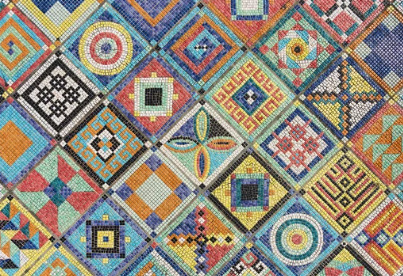
Imagine walking into a home where the first thing that catches your eye is a stunning mosaic tile entryway, its intricate patterns telling a story of craftsmanship and elegance. This is the power of mosaic tiles - small pieces of art that can transform a space and significantly boost a property's value. Let's embark on a journey to discover how these tiny treasures can make a big impact on your home's worth and appeal.
The Timeless Appeal of Mosaic Tiles
Mosaic tiles have been adorning homes for thousands of years, from ancient Roman villas to Byzantine churches. Today, they're experiencing a renaissance in modern homes, bringing a touch of timeless beauty to contemporary spaces. A trip to your local ceramic tile shop will reveal an astounding array of options, from classic designs to cutting-edge patterns.
According to a recent National Association of Realtors report, homes with high-quality tile work can see up to a 5-7% increase in value. That's a significant return on investment for a relatively simple upgrade. But how do you choose the right mosaic tiles for your home?
Choosing the Right Mosaic Tiles for Your Home
When you step into a ceramic tile shop, the choices can be overwhelming. But fear not - choosing the perfect mosaic tiles for your home is an adventure in creativity. Consider the material - ceramic, glass, stone, or metal - each brings its own unique character to your space. Think about size too; while all mosaic tiles are small, they can range from tiny 1/4 inch pieces to larger 2 inch squares, each creating a different effect.
Color is another crucial factor. Light-colored mosaic tiles can make a room feel more spacious and airy, perfect for small bathrooms or kitchens. Darker tones, on the other hand, can add depth and coziness to larger spaces. And don't forget about patterns - from simple geometric designs to complex pictorial scenes, the pattern of your mosaic tiles can set the tone for the entire room.
Lastly, consider the grout. It's not just the glue that holds your tiles together; it's an design element in its own right. A contrasting grout color can make your mosaic tiles pop, while a matching color can create a more subtle, unified look.
Where to Use Mosaic Tiles for Maximum Impact
Now that you've chosen your perfect mosaic tiles, where should you use them to add the most value to your property? Let's take a tour through a home and explore the possibilities.
We'll start in the kitchen, where a mosaic tile backsplash can be the star of the show. It not only protects your walls from splashes and spills but also adds a pop of color and personality. According to a study by Houzz, 87% of homeowners upgrading their kitchens chose to install new backsplashes, with mosaic tiles being a popular choice.
Moving to the bathroom, mosaic tiles reign supreme. They're water-resistant, easy to clean, and can add a spa-like luxury to your space. Picture a shower enclosure with shimmering glass mosaic tiles, or a vanity backsplash that catches the light just so.
In the entryway, mosaic tiles can make a lasting first impression. A beautiful mosaic floor or accent wall sets the tone for your entire home, welcoming guests with a touch of artistry.
Don't forget about outdoor spaces! A plain patio can be transformed into a Mediterranean-inspired retreat with the right mosaic tiles. They're durable enough to withstand the elements and can add a touch of sophistication to your outdoor living areas.
Finally, consider giving your fireplace a facelift with mosaic tiles. A tiled surround can turn a boring fireplace into a stunning centerpiece, making a big impact in your living room with a relatively small investment.
The DIY Route vs. The Professional Touch
For the handy homeowner, installing mosaic tiles can be a rewarding DIY project. Many ceramic tile shops offer DIY-friendly options, such as mosaic sheets that make installation easier. The process involves preparing the surface, planning your layout, applying adhesive, placing the tiles, grouting, and finally cleaning and sealing.
However, if you're not confident in your DIY skills or you're dealing with a large or complex project, hiring a professional can ensure a flawless finish. Many ceramic tile shops can recommend reputable installers in your area. According to HomeAdvisor, the average cost to install mosaic tiles ranges from $10 to $30 per square foot, including materials and labor. While this might seem steep, remember that quality installation can significantly impact the value added to your home.
Maintaining Your Mosaic Masterpiece
To keep your mosaic tiles looking their best and maintain your property's value, regular maintenance is key. Think of it as caring for a work of art - which, in essence, it is. Clean your tiles regularly with a pH-neutral cleaner, avoiding harsh chemicals that can damage the tiles or grout. Reseal grout lines annually to prevent staining and moisture penetration. And if you notice any loose or damaged tiles, address them promptly to prevent further issues.
The ROI of Mosaic Tiles
While the upfront cost of mosaic tiles might be higher than some alternatives, the return on investment can be substantial. A study by Remodeling Magazine found that minor kitchen remodels, which often include new tile work, can recoup up to 80% of their cost at resale.
Moreover, homes with unique, high-quality features like custom mosaic tile work tend to sell faster. In a competitive real estate market, these distinctive touches can give your property a significant edge. It's not just about the monetary value - it's about creating a home that stands out in potential buyers' minds.
Eco-Friendly Options and Current Trends
For the environmentally conscious homeowner, many ceramic tile shops now offer eco-friendly mosaic tile options. These can include recycled glass tiles, tiles made from sustainable materials like bamboo or cork, or locally sourced stone tiles to reduce transportation emissions. Using sustainable materials not only adds value to your home but also appeals to the growing market of eco-conscious buyers.
As for current trends, geometric patterns are having a moment, as are neutral color palettes with pops of bold color. Large-format mosaic designs are gaining popularity, and metallic and iridescent finishes are adding a touch of glamour to many homes. Staying current with these trends can help ensure your home feels modern and appealing to potential buyers.
Conclusion: Small Tiles, Big Value
From ancient art form to modern design staple, mosaic tiles have stood the test of time. Their versatility, durability, and sheer beauty make them an excellent choice for homeowners looking to add value to their property.
Whether you're planning a major renovation or just want to update a small area, mosaic tiles offer endless possibilities. With careful selection from your ceramic tile shop and proper installation, these tiny pieces of art can have a big impact on your home's value and appeal.
Remember, the key to success with mosaic tiles is quality - in materials, design, and installation. So take your time, plan carefully, and don't be afraid to seek professional help if needed. The result will be a beautiful, valuable addition to your home that you'll enjoy for years to come. After all, in the world of home improvement, sometimes the smallest details can make the biggest difference.
3 notes
·
View notes
Text
Hexagon tiles have become a popular choice in interior design due to their unique shape
Hexagon tiles have become a popular choice in interior design due to their unique shape, versatility, and timeless appeal. Whether you’re planning a bathroom renovation, kitchen upgrade, or looking for a creative backsplash, hexagon tiles can elevate the aesthetic of any space. This article will explore the various applications of “hexagon tiles”, their design benefits, and how they can transform your home.
Why Choose Hexagon Tiles for Your Home?
Hexagon tiles, often referred to as “hex tiles” stand out due to their geometric shape and ability to create intricate patterns. These six-sided tiles can be used in numerous ways, from flooring to wall installations, offering both functional and decorative solutions. Here’s why homeowners and designers love hexagon tiles:
Unique Shape: The geometric shape adds visual interest and can make spaces appear more dynamic.
Variety of Materials: Available in ceramic, porcelain, stone, glass, and even metal, hexagon tiles can complement any design style.
Versatile Use: They are suitable for bathrooms, kitchens, entryways, and even outdoor spaces.
Timeless Appeal: Hexagon tiles have a long history in design, yet they remain a contemporary choice, fitting both classic and modern interiors.
Types of Hexagon Tiles Ceramic Hexagon Tiles Ceramic hexagon tiles are one of the most popular choices due to their affordability and ease of installation. They come in various colors and sizes, allowing for customization to suit different design preferences.
Benefits of Ceramic Hexagon Tiles Cost-Effective: Ceramic tiles are typically more affordable than natural stone or porcelain options.
Variety of Colors and Finishes: Available in glossy, matte, or textured finishes, ceramic hexagon tiles offer a range of visual options.
Easy Maintenance: These tiles are easy to clean and maintain, making them ideal for high-traffic areas like bathrooms and kitchens.
Porcelain Hexagon Tiles Porcelain hexagon tiles are known for their strength and durability, making them suitable for both residential and commercial applications. They are often used in areas that require high durability, such as floors or outdoor spaces.
Why choose porcelain hexagon Tiles?
Durability: “Porcelain tiles” are incredibly durable and resistant to water, making them perfect for bathrooms, kitchens, and outdoor patios.
Design Flexibility: Porcelain hexagon tiles can mimic the look of natural stone or wood, providing more design options.
Low Porosity: Their low water absorption rate makes porcelain tiles highly resistant to stains and moisture.
Stone Hexagon Tiles For a luxurious and natural look, stone hexagon tiles are a stunning choice. Available in materials like marble, granite, and travertine, stone hexagon tiles add a touch of elegance to any space.
Benefits of Stone Hexagon Tiles Luxurious Appearance: “Natural stone hexagon tiles” bring a sense of elegance and sophistication to any room.
Durability: Stone tiles are highly durable and can last for decades with proper care.
Unique Patterns: Each stone tile is unique, offering one-of-a-kind patterns and variations in color and texture.

Applications of Hexagon Tiles in the Home
Hexagon tiles are incredibly versatile and can be used in a wide range of applications. Whether you want to add a bold statement to your walls or create a subtle, classic look for your floors, hex tiles can be adapted to your vision.
Hexagon Tiles for Bathroom Design One of the most popular uses for “hexagon tiles is in the bathroom”. These tiles work beautifully for both floors and walls, providing a stylish and functional solution. The geometric shape adds visual interest, while the tile material — whether ceramic, porcelain, or stone — provides durability.
Bathroom Floor with Hexagon Tiles Hexagon tiles create a stunning effect when used on bathroom floors. Smaller hex tiles in light or neutral tones can make a small bathroom feel larger, while larger tiles in bold colors can add drama and sophistication.
Non-Slip Options: Many hex tiles have textured surfaces, making them a safer option for wet areas like bathroom floors.
Water Resistance: Porcelain and ceramic hex tiles are highly water-resistant, making them perfect for bathrooms where moisture is a concern.
Hexagon Tile Backsplashes In addition to flooring, “hexagon tiles” can be used as an eye-catching backsplash in bathrooms. Whether you choose a simple white tile or a bold, colorful design, a hex tile backsplash adds texture and style.
Hexagon Tiles for Kitchens Kitchens are another great space to incorporate hexagon tiles. These tiles are durable, easy to clean, and can serve both functional and aesthetic purposes.
Hexagon Tile Backsplashes in the Kitchen Hex tiles are a popular choice for kitchen backsplashes due to their ability to add a modern touch while being easy to maintain. The tiles protect walls from splashes and spills while contributing to the overall design of the kitchen.
Subtle or Bold: White hexagon tiles offer a minimalist, clean look, while colored or patterned hex tiles can create a striking focal point.
Customizable Patterns: Arrange hex tiles in a staggered or symmetrical pattern for different effects.
Hexagon Tiles for Kitchen Floors
Hexagon tiles are also a practical and stylish option for kitchen floors. Porcelain hex tiles, in particular, offer the durability needed in a busy kitchen environment. Their water and stain resistance make them easy to clean and maintain, ensuring your kitchen stays looking fresh.
Hexagon Tiles for Living Spaces Hexagon tiles aren’t just for kitchens and bathrooms; they can also be used to add texture and style to living spaces. From accent walls to entryways, hex tiles offer endless design possibilities.
Accent Walls with Hexagon Tiles Create a bold statement by “using hexagon tiles on a feature” wall in your living room or hallway. Whether you choose a monochromatic scheme or mix and match colors, a hex tile accent wall adds visual depth and texture to any space.
Popular Patterns and Layouts for Hexagon Tiles
Hexagon tiles offer flexibility when it comes to patterns and layouts. You can arrange them in several ways to achieve different visual effects, making them an exciting option for creative design projects.
Classic Honeycomb Pattern The most common layout for hexagon tiles is the honeycomb pattern, which showcases the tiles’ geometric shape. This pattern is perfect for creating a clean, modern look in both bathrooms and kitchens.
Randomized Patterns For a more eclectic look, you can arrange “hexagon tiles” in a randomized pattern. This involves using hex tiles of different colors or shades and placing them randomly on the floor or wall to create a unique design.
Border or Accent Patterns Hexagon tiles can also be used to create borders or accents within a larger tile layout. For example, you can use small hex tiles to outline a square tile layout, adding depth and contrast to the design.
Frequently Asked Questions (FAQ)
What are hexagon tiles made of? Hexagon tiles come in a variety of materials, including ceramic, porcelain, natural stone, glass, and metal. Each material offers different benefits in terms of durability, appearance, and maintenance.
Are hexagon tiles suitable for floors? Yes, hexagon tiles are highly durable and can be used for both floors and walls. Porcelain and stone hex tiles are particularly suitable for flooring, as they are resistant to wear and moisture.
How do I maintain hexagon tiles? Maintenance depends on the tile material. Ceramic and porcelain hex tiles are easy to clean with water and mild detergent, while natural stone tiles may require periodic sealing to protect them from stains and moisture.
Can hexagon tiles be used outdoors? Yes, porcelain and stone hexagon tiles are durable enough for outdoor use. They are resistant to moisture, temperature changes, and wear, making them a great option for patios, walkways, and outdoor walls.
Conclusion Hexagon tiles are a versatile and stylish choice for any home. With their unique geometric shape, wide range of material options, and endless design possibilities, they can enhance the look of your kitchen, bathroom, or living space. Whether you’re drawn to the classic honeycomb pattern or prefer a more randomized, eclectic look, hex tiles offer a timeless and modern appeal that suits both contemporary and traditional designs.
#brceramics#decor#buildings#design#home#home decor#interiors#kitchen#bedroom#hexagon wall tiles#kitchen tiles price#Hexagon tiles design#Hexagon tile#Hexagon tiles kitchen#Hexagon tile bathroom
1 note
·
View note
Text

A small kitchen with a bamboo floor and a farmhouse sink, shaker cabinets, beige cabinets, quartzite countertops, a metallic or glass tile backsplash, stainless steel appliances, and no island is an example of a kitchen design.
Kinderkoor Kikoti
0 notes
Text
Elevate Your Kitchen with the Perfect Color Palette
The kitchen is no longer just a space for cooking—it’s where conversations spark, creativity flows, and style takes center stage. At WeDezine Studio, we believe your kitchen should be a seamless blend of function and fashion. One of the most powerful ways to achieve a luxurious, polished look? Choosing the right color palette.
Whether you're renovating from the ground up or simply refreshing your space, a well-curated color scheme can elevate your kitchen from average to exceptional. Here's how our designers at WeDezine help homeowners craft kitchens that feel custom, curated, and completely timeless.
Why Color Palettes Are the Heart of Kitchen Design
The colors you choose influence not just the aesthetics, but the ambiance, perceived space, and lighting. A sophisticated palette sets the tone for elegance, harmony, and modern luxury.
At WeDezine Studio, our expert team combines design intuition with color science to guide you toward choices that complement your layout, natural lighting, and lifestyle.
Step-by-Step: Designing Your Kitchen with Color in Mind
1. Define Your Kitchen’s Identity
Every kitchen has a story to tell. Before selecting shades, we help you identify your design direction:
Modern & Sleek: Neutral foundations with striking accent colors
Classic & Traditional: Rich, warm tones with timeless finishes
Minimalist & Airy: Light neutrals, clean lines, and textural layers
Matching your palette to cabinetry, flooring, and fixtures ensures visual flow and functional beauty.
2. Embrace the Power of Neutrals
For a clean, upscale look, our designers often start with a neutral base. Shades like ivory, soft grey, and greige never go out of style and work beautifully with a wide range of accent materials.
Signature Combinations by WeDezine:
White cabinetry + gold hardware for a high-end touch
Greige walls + matte black faucets for modern edge
Cream tones + natural wood for depth and warmth
3. Add Dimension with Dark Accents
Deep hues such as navy, forest green, or charcoal inject richness and drama. When used intentionally, darker colors create focal points and luxurious contrast.
WeDezine Dark Palette Ideas:
Midnight blue cabinets + brass pulls
Matte black backsplash + beige or ivory walls
Emerald island + oak wood open shelving
4. Explore Pastels for a Soft Sophistication
Looking to strike a balance between modern and cozy? WeDezine loves incorporating gentle pastel tones for clients seeking something distinctive yet refined.
Try:
Powder blue cabinetry
Dusty rose tiles
Lavender grey wall paint
Perfect for adding charm and personality without overwhelming the space.
5. Master the Art of Warm & Cool Tones
One of our signature techniques is blending warm and cool undertones to create dynamic, balanced interiors. For instance:
Cool grey cabinetry + warm oak floors
Beige quartz countertops + soft sage walls
Our designers always test paint samples under varied lighting to ensure the hues perform beautifully day and night.
6. Choose the Right Finishes
The finish can make or break your palette. At WeDezine, we advise finishes based on both aesthetics and practical needs:
Matte: Understated elegance
Glossy: Easy-clean, modern shine
Satin/Semi-gloss: Versatile and refined
7. Layer with Texture and Metal Accents
A sophisticated kitchen isn’t just about color—it’s about depth and detail. We love mixing tones with high-end finishes like:
Textured stone or handmade tiles
Brushed brass, matte black, or copper fixtures
Raw wood beams or waterfall stone countertops
8. Go Bold with Two-Tone or Monochrome
WeDezine clients love our two-tone kitchen concepts, such as dark lower cabinets with light uppers, or soft monochromatic palettes with varying tints and tones.
These techniques help define space, break visual monotony, and work for kitchens big and small.
The WeDezine Approach to a Stylish Kitchen
Our designers follow the golden 60-30-10 rule:
60% dominant/base color
30% secondary shade
10% accent color or metal finish
We also ensure your kitchen’s palette flows with the rest of your home for a consistent, curated experience.
Ready to Transform Your Kitchen?
Choosing the right palette isn’t just a design step—it’s the foundation of a kitchen you’ll love for years to come. At WeDezine Studio, we craft personalized color stories that reflect your taste and enhance your space with elegance and purpose.
Let us help you bring your dream kitchen to life—from color concepts to complete transformations.
Book your consultation today at wedezinestudio.com
0 notes
Text
How to Choose the Perfect Color Palette for a Sophisticated Kitchen
Your kitchen is more than just a space for cooking — it’s a reflection of your personal taste and a central part of your home’s design. The right color palette can elevate your kitchen into a refined, high-end space that blends style with function. Whether you're renovating or building from scratch, choosing the right tones is the first step toward achieving that elegant, sophisticated kitchen look.
In this guide, we’ll walk you through how to select the ideal kitchen color scheme that feels timeless, modern, and truly luxurious.
Why Color Selection Matters in Kitchen Design
Color sets the tone — literally — for your kitchen’s ambiance. A well-balanced palette enhances natural light, adds personality, and defines your design style. Whether you want a minimal, modern look or a warm, inviting space, your kitchen wall and cabinet colors will lead the way.
1. Match Colors to Your Kitchen Style
Start by identifying your kitchen’s design direction:
Contemporary kitchens thrive on contrast — think white and charcoal, or navy and gold.
Classic kitchens lean into warm tones like beige, off-white, and walnut.
Minimalist kitchens favor clean, monochrome palettes with subtle texture.
Let the style of your cabinets, flooring, and lighting influence your color decisions.
2. Neutrals That Never Fail
Neutral shades are the backbone of elegant kitchen design. Hues like ivory, soft grey, cream, taupe, and matte white bring calm, balance, and timelessness.
Classic Combos:
Ivory cabinetry with brushed gold fixtures
Soft grey walls paired with white marble countertops
Cream tones with natural wood flooring
These combinations work across all kitchen sizes, making your space feel brighter and more open.
3. Sophistication Through Dark Tones
Deep shades bring drama, luxury, and richness to a kitchen — especially when used as accents or cabinet colors.
Top Picks:
Navy Blue: Works beautifully with white stone and brass
Charcoal Grey: Perfect for lower cabinets or islands
Forest Green: Adds an earthy, moody feel
Contrast these darker shades with light countertops or backsplashes for depth and balance.
4. Embrace Soft Pastels for Modern Warmth
Pastels aren’t just for kids’ rooms — they bring a fresh, calming vibe to kitchens when used thoughtfully.
Try:
Mint green cabinets with white tiles
Dusty rose accents paired with matte black fixtures
Powder blue backsplashes for a serene backdrop
Pastels work best in kitchens that receive natural light and are ideal for creating a warm, welcoming space.
5. Blend Warm and Cool Tones for Visual Balance
Combining warm and cool shades creates a layered, designer look. A cool grey island with warm wooden bar stools, or beige walls with stainless steel appliances, offers contrast without clashing.
Always test your chosen shades in natural light and at different times of day before finalizing the palette.
6. Think Beyond Paint: Use Finishes and Textures
Paint color is just one part of the palette. Material finishes and textures also influence how your kitchen feels.
Glossy finishes reflect light and feel modern
Matte finishes provide subtle elegance and work well in muted designs
Natural textures like wood, stone, or brushed metal add richness and depth
7. Try Monochrome or Two-Tone Color Schemes
A monochrome palette — using varying tones of a single color — adds elegance and calm.
A two-tone kitchen — like dark base cabinets and lighter uppers — adds contrast and visual interest.
These layouts are trendy, highly functional, and look polished in both large and small kitchen designs.
Final Thoughts
Choosing the right kitchen color palette isn’t just about what looks trendy — it’s about what feels right for your space, your lifestyle, and your aesthetic. Whether you love bold contrasts or soothing neutrals, aim for balance, flow, and personality in every shade you choose.
At WeDezine Studio, we specialize in creating interiors that speak to your vision. From concept to completion, we’ll help you bring your dream kitchen to life with the perfect combination of colors, materials, and textures.
0 notes
Text
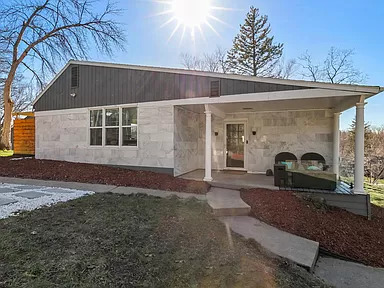
I have never seen anything like this remodeled 1930 home in Rochester, MN. It has 3bds, 3ba, and is completely tiled inside and out. The exterior is basically bathroom tile. Asking $849K. Well, at least you don't have to ever paint, just spray it down with shower cleaner.
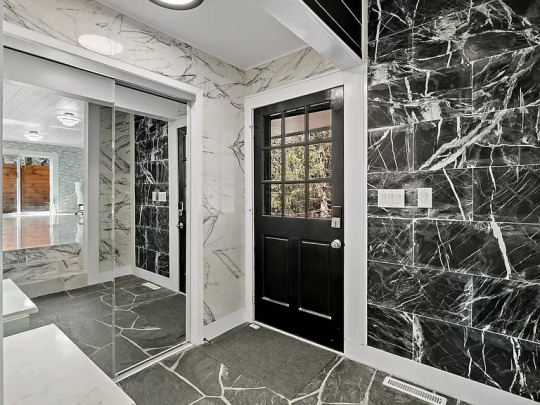
You'd think that it would at least be something other than the usual white, gray, and black. And, you don't even have the option of painting. Ever.
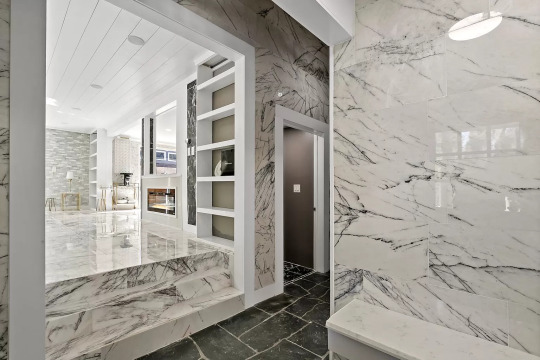
Tile stairs go up into the living room.
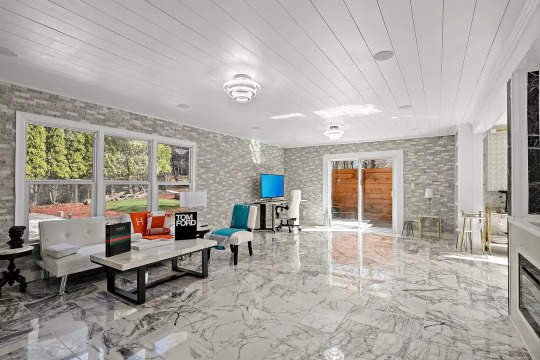
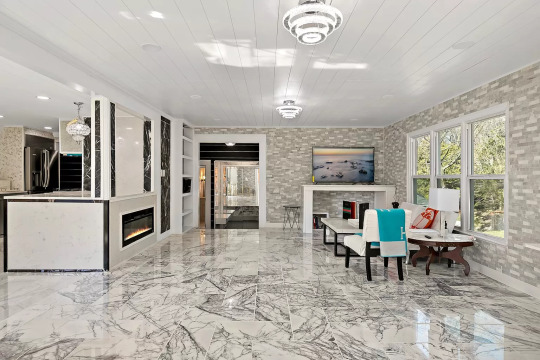
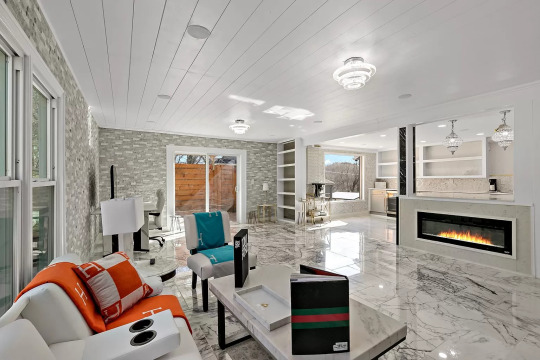
I don't really like the small subway-type tiles on the walls in here. Even the fireplace is tile. The bookshelves & ceilings, however, are wood.
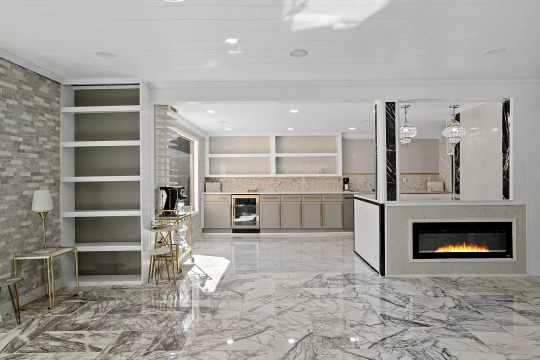
I've never seen a combination fireplace/kitchen counter.
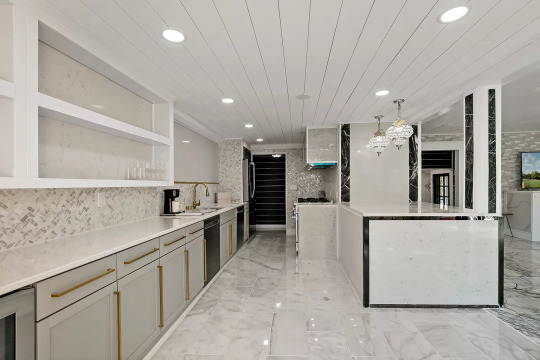
The lower cabinets are nice.
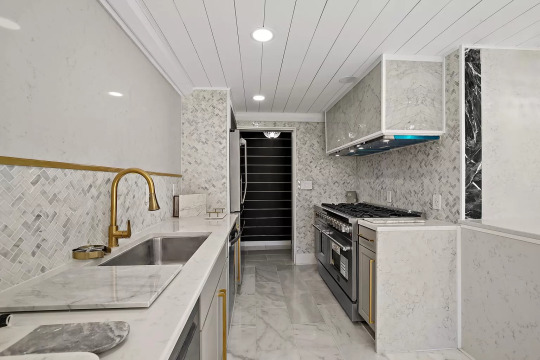
The backsplash is a herringbone pattern.
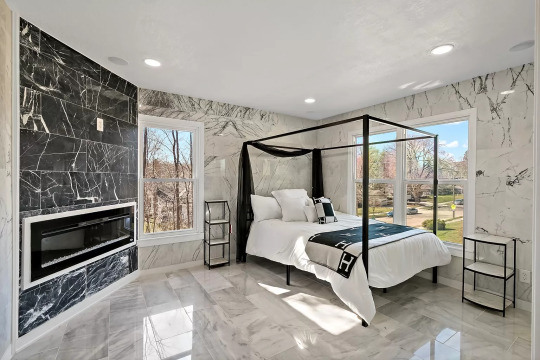
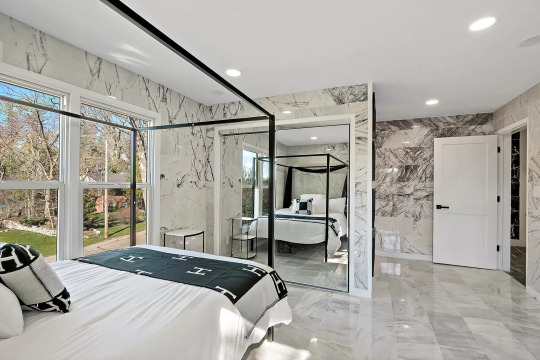
The primary bedroom has a fireplace wall. As if it doesn't have enough shine, they had to put mirrored doors on the closets.
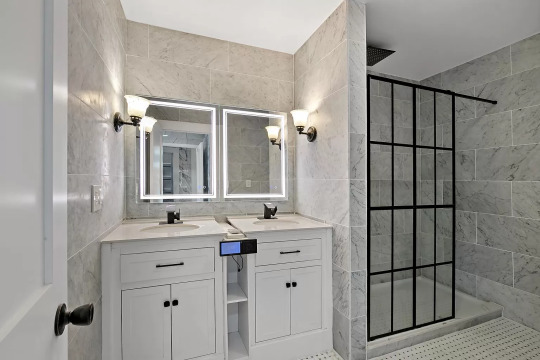
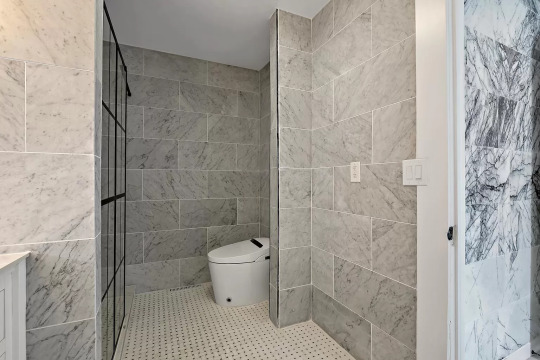
The en-suite bath has that nice shower door that looks like paned glass.
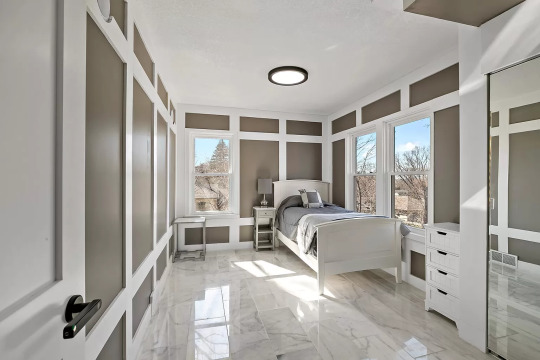
What is this nonsense? No tiled walls? This is actually very nice. It can be repainted in a very attractive color scheme.
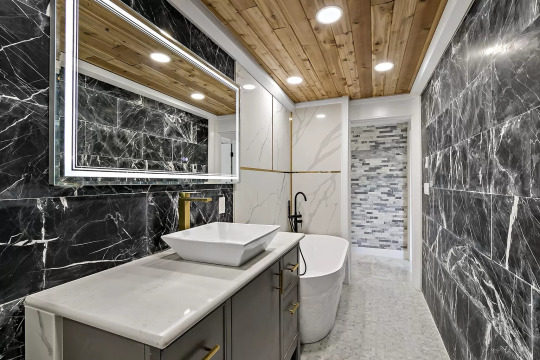
Bath #2 has large pieces of tile joined by metal strips around the tub, plus a wood-tone ceiling. There are 4 different tiles in here.
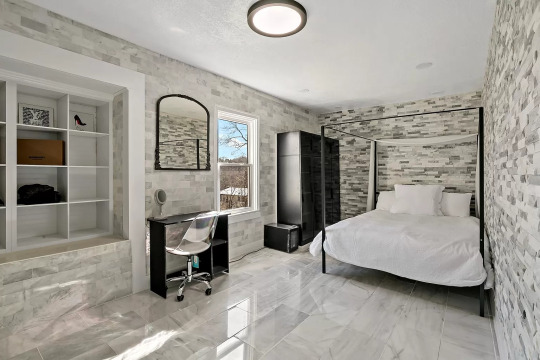
Bedroom #3 has the small tiles on the walls.
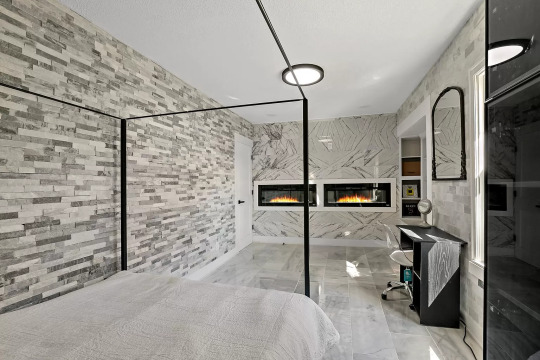
Well, that's different - twin fireplaces.
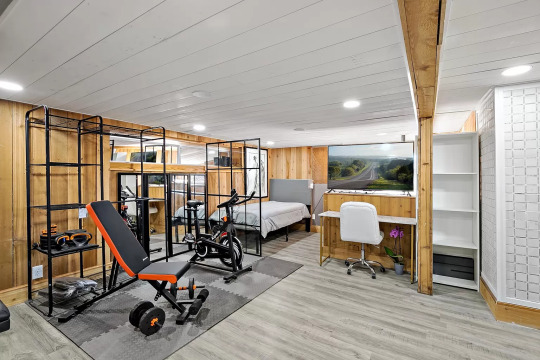
The finished basement is set up as someone's bedroom, office, and gym. I like the glass wall partition.
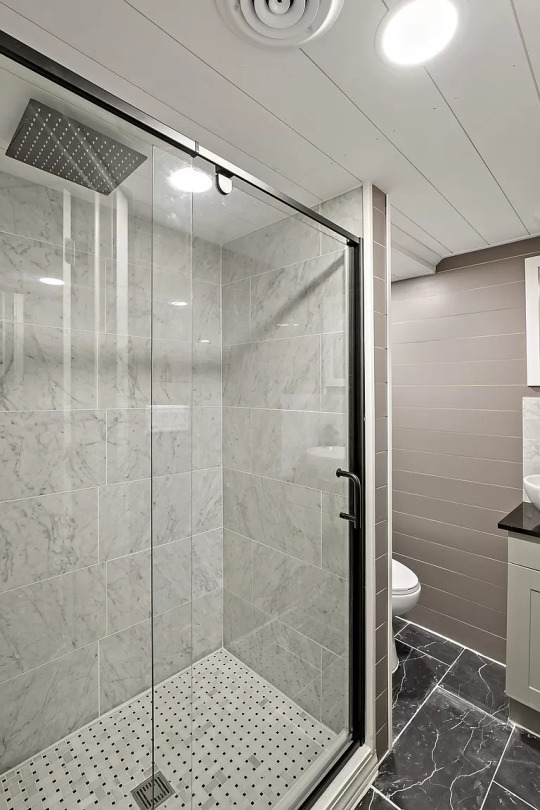
There's also a shower down here.
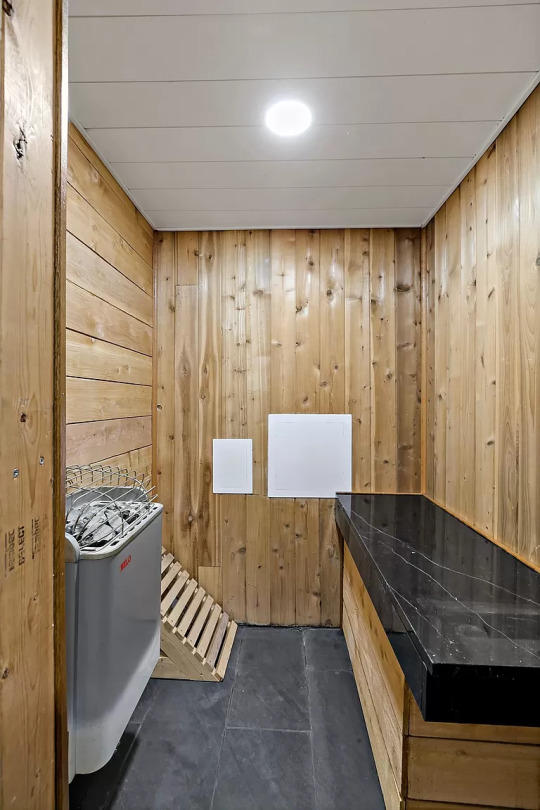
And, a sauna.
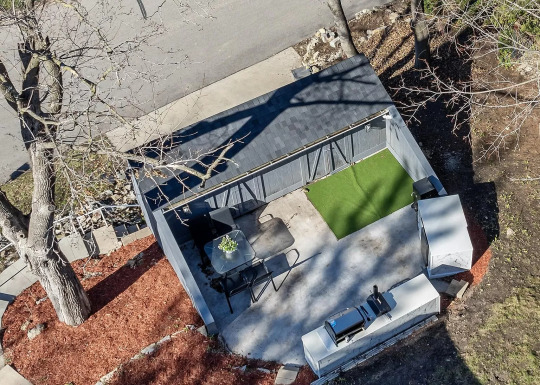
There's an outdoor kitchen with storage.
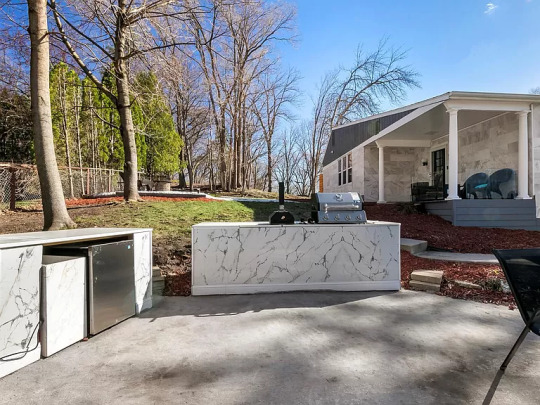
The kitchen is, of course, tile.
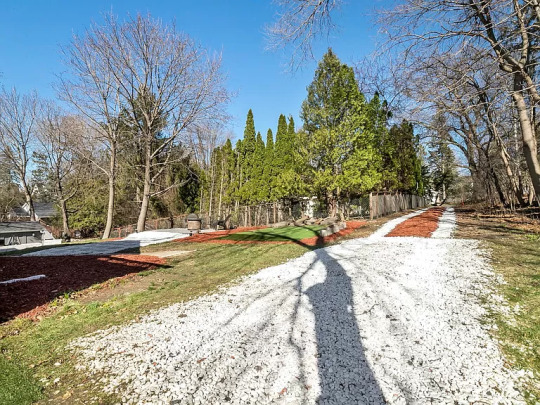
The lot is .25 acre.
https://www.zillow.com/homedetails/902-14th-Ave-SW-Rochester-MN-55902/91456791_zpid/?
460 notes
·
View notes
Text
Blending Mosaic Magic with Minimalist Charm: A Singapore Guide
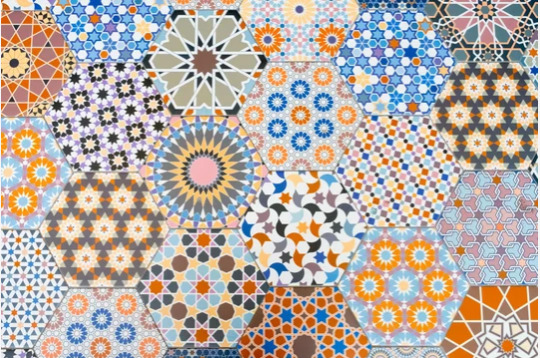
Are you looking to add a touch of personality to your sleek, modern home without overwhelming its clean lines? Mosaic tiles might be just the answer you're seeking. In this guide, we'll explore how to seamlessly incorporate mosaic tiles into a minimalist design, with a special focus on options available in Singapore's ceramic tile shops.
The Appeal of Mosaic Tiles in Modern Design
Mosaic tiles have been around for thousands of years, but they're far from outdated. These versatile little pieces can add texture, color, and interest to any space. In Singapore, where modern minimalist designs are all the rage, mosaic tiles are making a comeback in unexpected and exciting ways.
Mosaic tiles offer a unique combination of versatility, texture, customization, and durability. They come in countless colors, shapes, and materials, allowing you to add depth to flat surfaces without cluttering the space. You can create unique patterns to suit your style, and many mosaic tiles are long-lasting and easy to clean, making them a practical choice for any home.
Finding the Right Mosaic Tiles in Singapore
Singapore boasts a thriving scene of ceramic tile shop, offering a wide range of mosaic tiles to suit any taste. When shopping for mosaic tiles in Singapore, consider the material, color, size, and finish of the tiles.
Materials like glass, ceramic, stone, or metal each have their unique look and feel. For a true minimalist vibe, stick to neutral tones, or add a pop of color for contrast. The size of the tiles can also impact the overall look - smaller tiles create more intricate patterns, while larger ones offer a cleaner look. As for finish, matte tiles blend well with minimalist designs, while glossy tiles can add a subtle shine.
Incorporating Mosaic Tiles into Minimalist Spaces
Now, let's dive into some creative ways to use mosaic tiles in your minimalist home:
Backsplash Brilliance: A mosaic tile backsplash in the kitchen or bathroom can add interest without overwhelming the space. In Singapore's ceramic tile shops, you'll find plenty of options for subtle, monochromatic mosaic tiles that complement minimalist designs perfectly.
Accent Walls with Attitude: Create a focal point in your living room or bedroom with a mosaic tile accent wall. Stick to neutral colors or go for a tonal palette to maintain the minimalist aesthetic.
Floor Flair: Use mosaic tiles to define spaces in an open-plan layout. A mosaic tile "rug" in the dining area or entryway can add visual interest while maintaining clean lines.
Shower Power: Transform your minimalist bathroom with a mosaic tile shower enclosure. Many ceramic tile shops in Singapore offer water-resistant options perfect for this purpose.
Artistic Touches: Create abstract art pieces using mosaic tiles. This allows you to add color and texture to your walls without cluttering the space.
Tips for Balancing Mosaic Tiles and Minimalism
When incorporating mosaic tiles into a minimalist design, remember that less is more. Use mosaic tiles sparingly to create impact without overwhelming the space. Choose tiles that complement your existing color palette and use them to add depth to otherwise flat surfaces.
Consider the scale of your mosaic tiles - larger tiles can create a more minimalist look than tiny, intricate patterns. Always balance your mosaic tile features with plenty of clean, empty space to maintain that minimalist feel.
Where to Find Mosaic Tiles in Singapore
Singapore is home to numerous ceramic tile shops offering a wide range of mosaic tiles. Start your tile-shopping adventure by researching online - many ceramic tile shops in Singapore have websites showcasing their products. However, it's always best to visit showrooms to see and feel the tiles in person before making a decision.
Don't hesitate to ask for samples; most shops will provide small samples to help you visualize the tiles in your space. And remember, the staff at these shops can be a valuable resource. Seek their expert advice on incorporating mosaic tiles into minimalist designs.
Conclusion
Incorporating mosaic tiles into a minimalist design might seem challenging, but with the right approach, it can elevate your space to new heights of style and sophistication. By choosing the right tiles and using them thoughtfully, you can create a home that's both sleek and full of personality.
Remember, the key to successful minimalist design is balance. With mosaic tiles, a little goes a long way in creating a space that's uniquely yours while maintaining that clean, uncluttered aesthetic we all love. So why not take a trip to your local ceramic tile shop in Singapore and start exploring the wonderful world of mosaic tiles today?
2 notes
·
View notes
Text
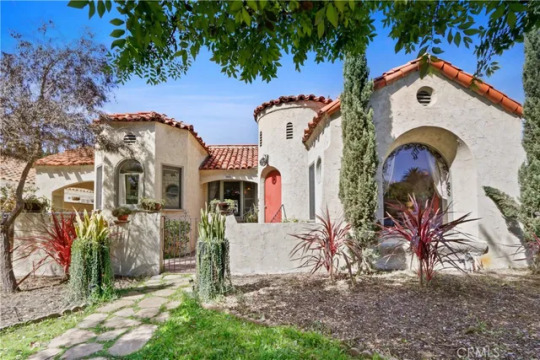
This 1928 Spanish Revival in Long Beach, CA has so many wonderful retro features that are preserved. 3bds, 2ba, $1.02M.
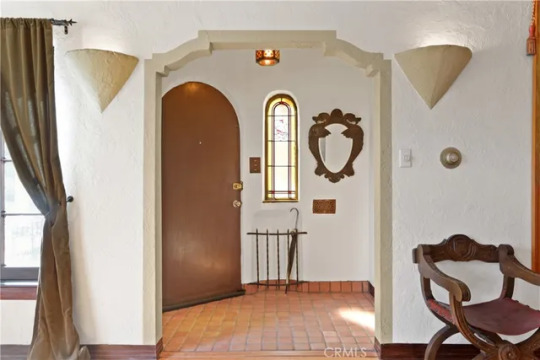
Small foyer with a fancy carved arch and sconces sculpted into the wall. I've never seen anything like that.
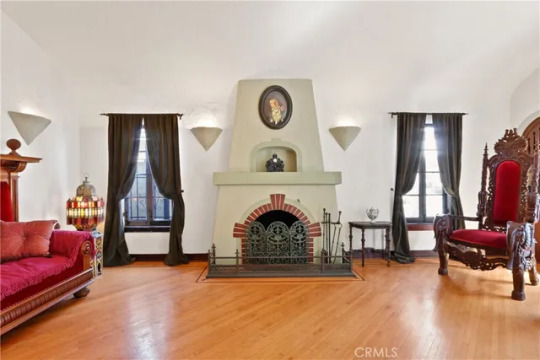
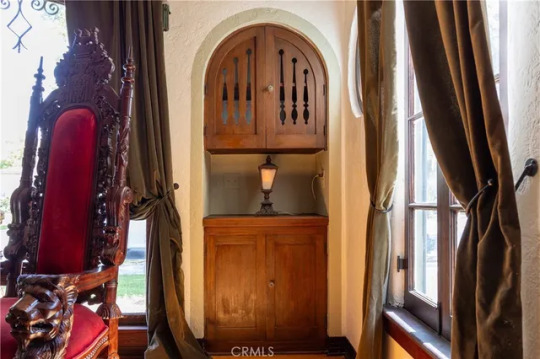
But, look, there're more. Beautiful Spanish style fireplace and a recessed built-in bar.
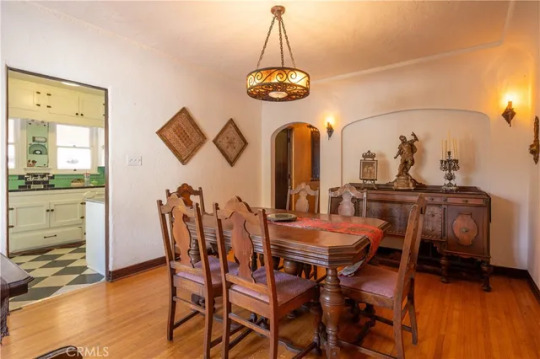
The dining room has a shallow recessed wall niche that's just big enough to highlight a sideboard.
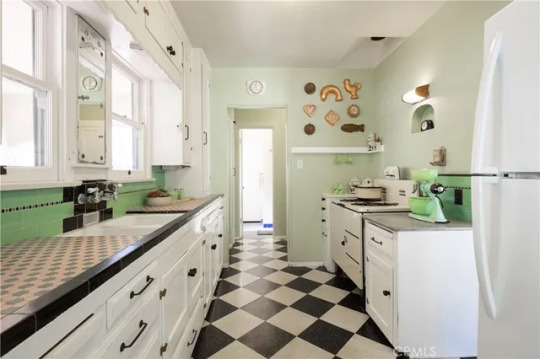
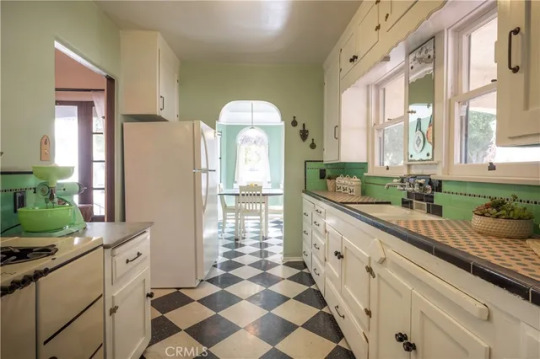
Check out this wonderful original kitchen. Vintage stove, cabinets, tile, everything. I have to appreciate how the owners took such good care of it.
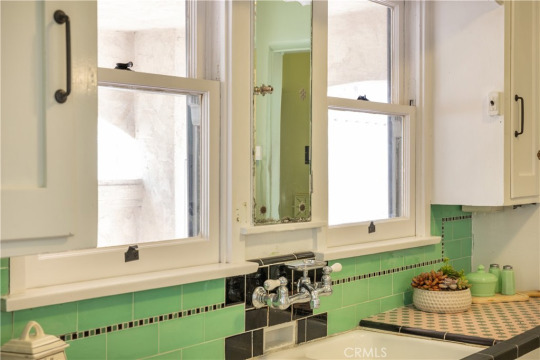
Original backsplash and faucet.
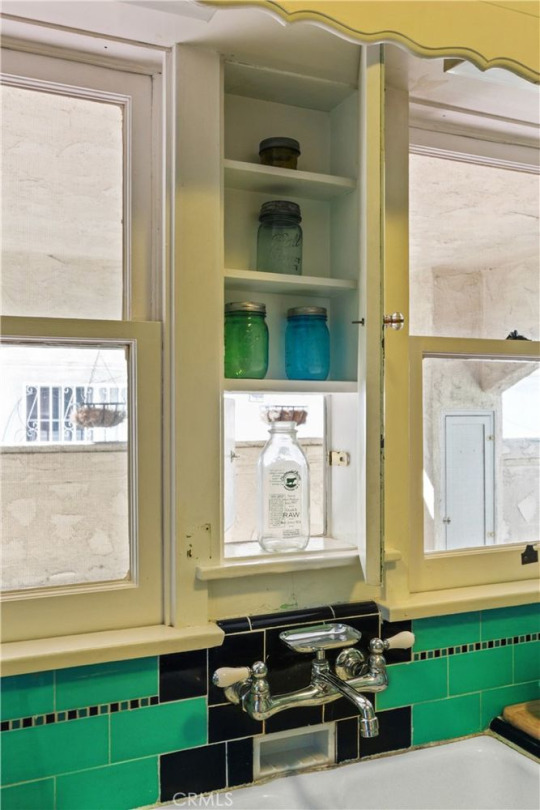
The mirrored door opens to the old milk delivery window. They must've put that little plastic shelf in the wall for steel wool soap pads (when everyone knows that you simply put them back in the box and they're good as new).
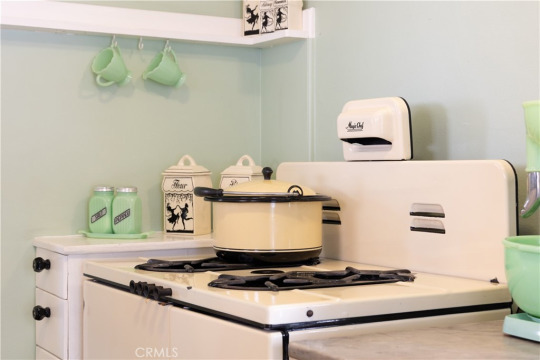
Wonderful vintage stove.
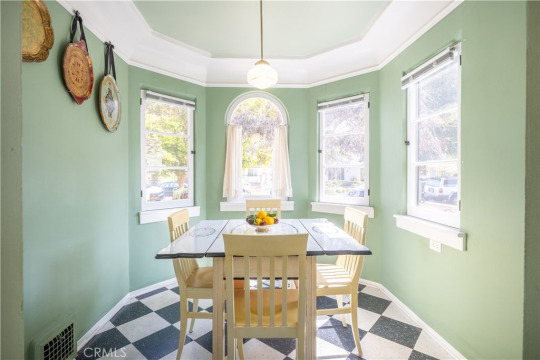
What a lovely, sunny kitchen dining space.
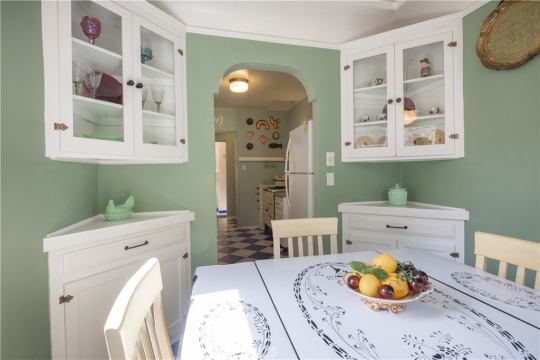
And, look, it has 2 corner cabinets.
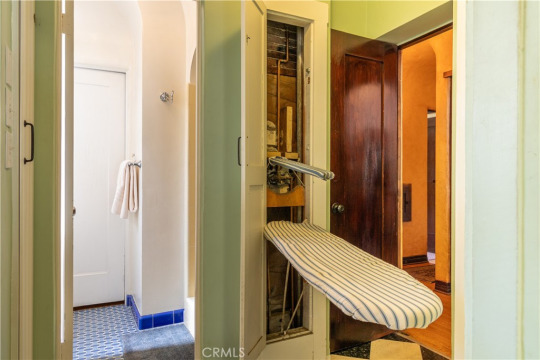
Check this out- not only does it have a folding ironing board, but it has a little board for sleeves.
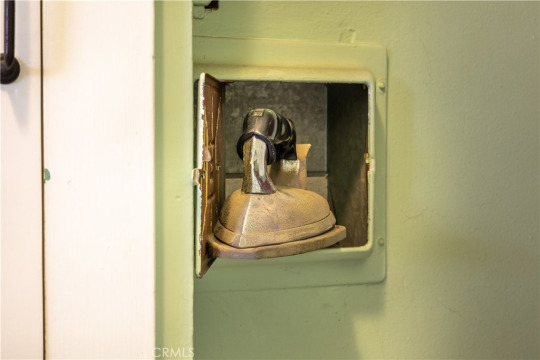
And, look at this- a little galvanized metal lined cabinet for the iron. I wonder if the vintage iron will convey.
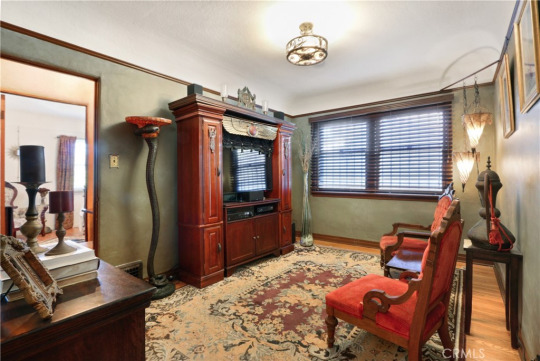
TV room. (Could they have chosen more uncomfortable chairs?)
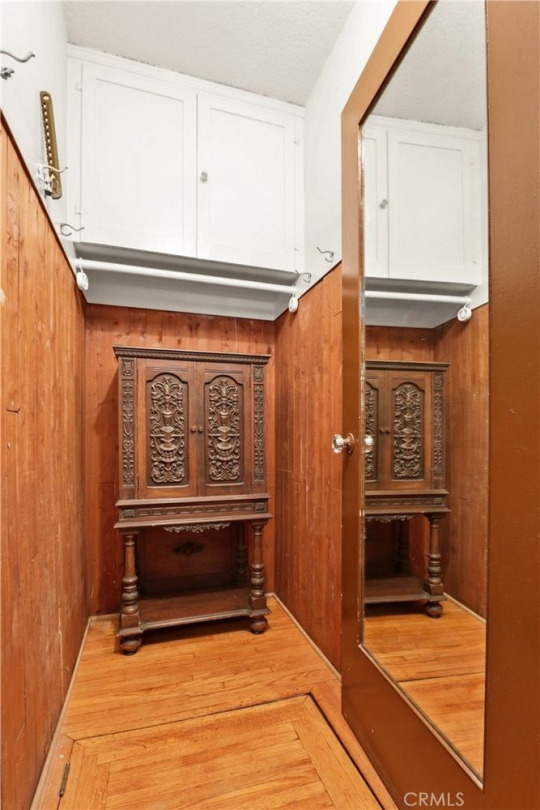
Now, here we are in a closet.
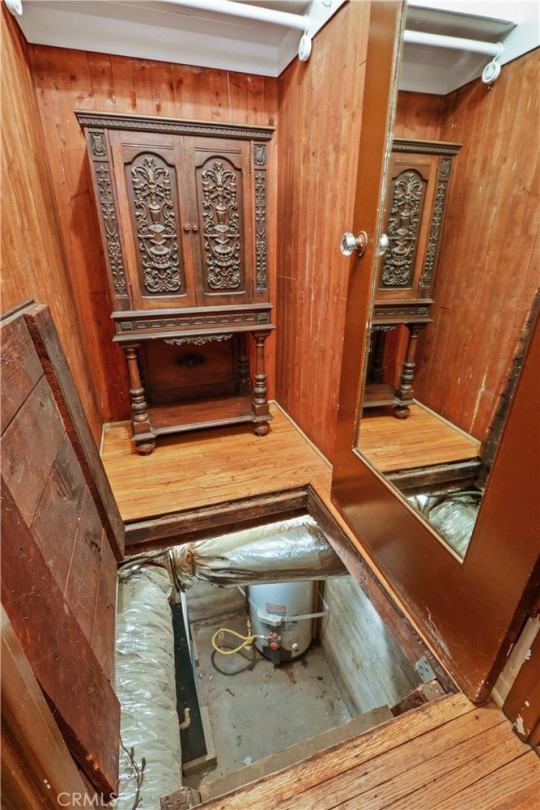
A trap door in the floor opens to the basement. Since I only see one step, it must have a ladder.
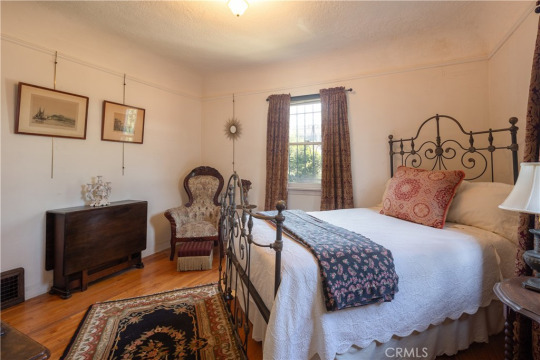
This bedroom is lovely, but it's not very big since they have the bed on an angle.
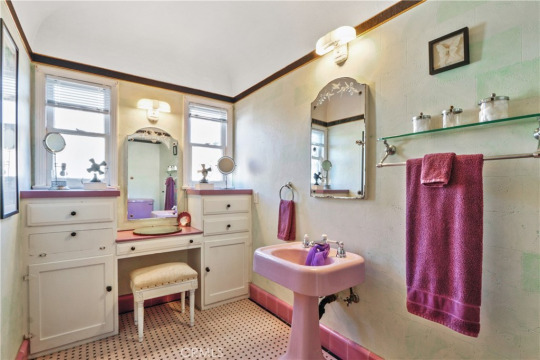
The bath! It has a big built-in vanity table.
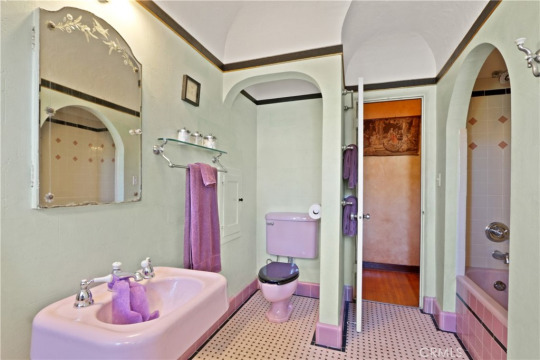
And, orchid plumbing fixtures. I've seen vintage colored sinks and tubs, but they always have a new white toilet. They may have gotten this toilet from an architectural salvage yard.
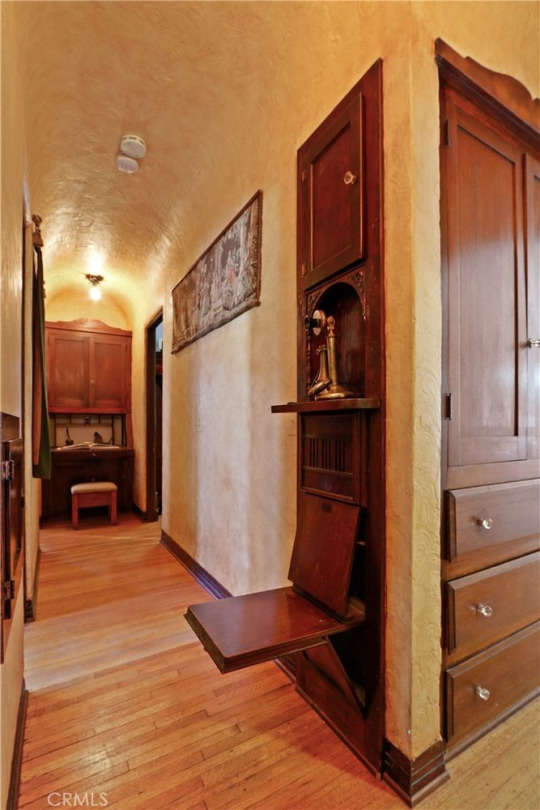
In the hall, ahead, there's a built-in desk. On the left is a built-in armoire. And, there's also a phone niche with a folding seat.
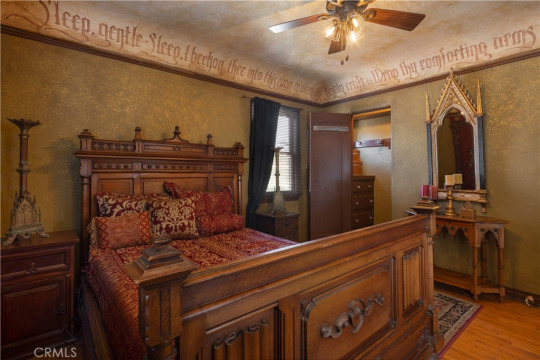
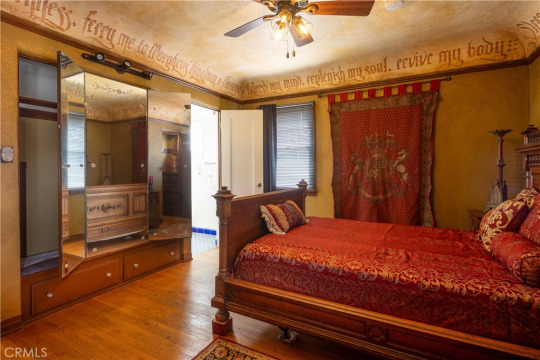
The primary bedroom is so royal looking. It looks like Old English around the ceiling border. And, look at the built-in with the pull-out mirrors.
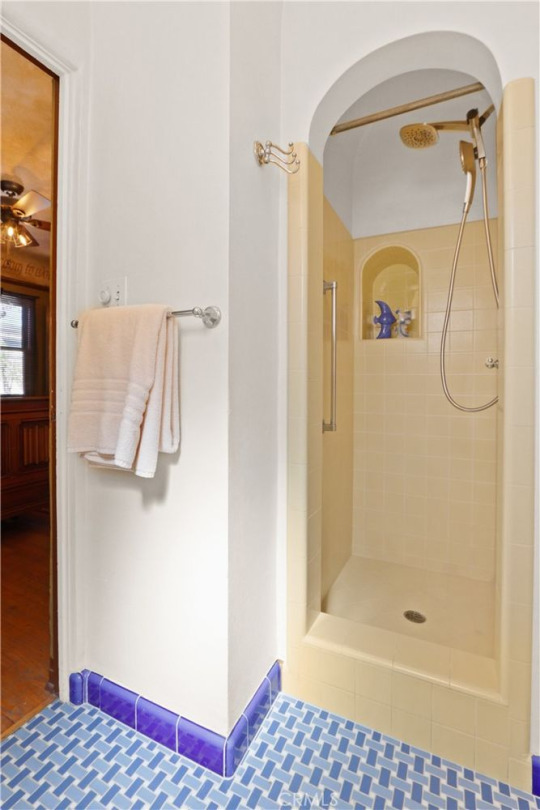
Beautiful vintage shower room.
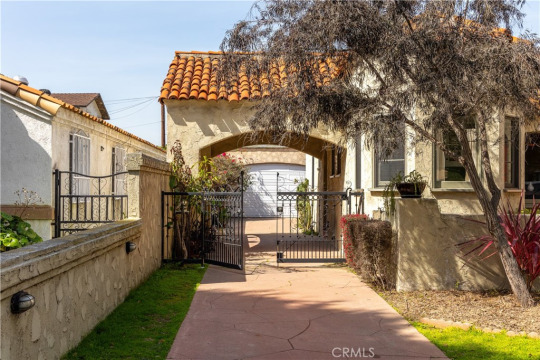
This home is amazing- gated driveway with porte cochere and 2 car garage.
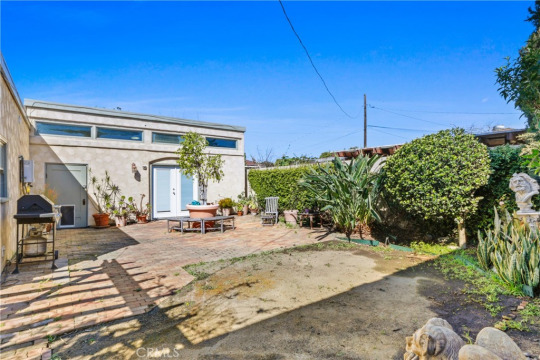
In the large yard is an addition.
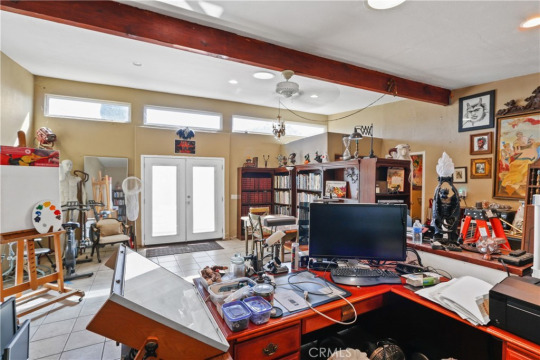
It's a large addition and has this great studio, plus 2 other big rooms that use for storage.
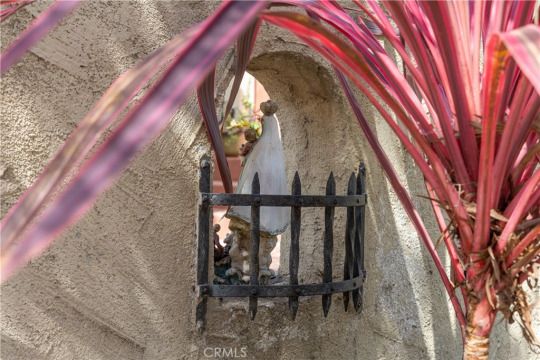
And, look at this detail in the wall outside- a little gnome niche.

The lot is .15 acre.
https://www.compass.com/listing/1985-san-francisco-avenue-long-beach-ca-90806/1532701137276580849/
171 notes
·
View notes
Text
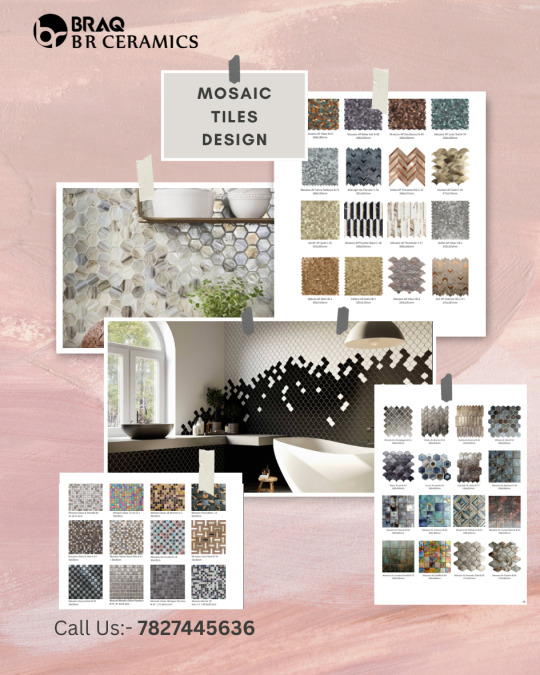
The Ultimate Guide to Glass, Mirror & Mosaic Floor Tiles: Trends, Prices, and Designs?
Introduction to Mosaic Tiles
Mosaic tiles have been used for centuries to beautify and personalize spaces. Whether you want a luxury bathroom or a striking kitchen backsplash, “mosaic tiles” are a go-to solution. They offer style, texture, and creative freedom in one compact design format.
What Are Mosaic Tiles?
“Mosaic tiles” are small pieces of materials such as glass, stone, ceramic, or metal arranged into a decorative pattern. They are usually mounted on a mesh backing to make installation easier and more uniform.
History and Evolution of Mosaic Tiles
The concept of “mosaic” art dates back to ancient Mesopotamia and Greece. Over time, the use of mosaics has expanded from palaces and churches to modern homes and commercial spaces, thanks to innovations in materials like glass and mirror.
Types of Mosaic Tiles
Glass Mosaic Tiles
Glass mosaic tiles are among the most popular choices for contemporary interiors. Their translucent quality and wide range of colors make them an excellent option for both walls and floors.
Features and Applications
Ideal for wet areas like bathrooms and pools
Reflect light beautifully, adding depth and dimension
Resistant to water and stains.
Benefits of Glass Mosaics
Easy to clean
Eco-friendly and recyclable
Highly customizable in terms of color and finish
Mirror Mosaic Tiles
Looking for a tile that doubles as decor? “Mirror mosaic tiles” might be your answer.
Aesthetic Impact of Mirror Mosaics
Mirror tiles reflect light and create an illusion of space, making small rooms feel bigger. Their shiny surface adds elegance and a modern edge to any room.
Ideal Spaces for Mirror Tiles
Bathroom walls
Accent walls in living rooms
Bar backsplashes and lounges
Mosaic Floor Tiles
When it comes to durability and design, “mosaic floor tiles” are hard to beat.
Durability and Functionality
Made to withstand foot traffic, these tiles are often slip-resistant and extremely long-lasting.
Top Mosaic Patterns for Flooring
Geometric patterns
Floral motifs
Mediterranean styles
Black-and-white checkerboards
Mosaic Wall Tiles
Wall applications are where mosaic tiles truly shine in home decor.
Creating Accent Walls
Use mosaic wall tiles to turn a dull wall into a focal point. Go bold with “mirror mosaics” or keep it chic with neutral-toned glass tiles.
Common Wall Installations
Kitchen backsplashes
Bathroom walls
Living room feature walls
Fireplace surrounds
Mosaic Tiles Design Ideas
Artistic Patterns and Layouts
Go beyond the basic. “Mosaic” designs can include herringbone patterns, chevron styles, and even 3D illusions.
Color Combinations that Pop
Try mixing warm and cool tones. Combine white glass with blue or green accents for a coastal vibe, or go metallic for a luxury feel.
Mosaic Tiles in Modern Interiors
From minimalist Scandinavian themes to bold industrial looks, “mosaic tiles” adapt easily to modern aesthetics. Use them in nooks, entryways, and shower areas for a sleek finish.
Understanding Mosaic Tiles Pricing
Mosaic Tiles Price in China
China is a global hub for tile manufacturing, offering competitive prices. The “price range for mosaic tiles” in China typically falls between $5 to $30 per square meter, depending on material, design, and quantity.
Factors Affecting Mosaic Tile Costs
Material: Glass is typically cheaper than stone or metal.
Size: Smaller tiles usually cost more per unit area.
Finish: Glossy or matte affects pricing.
Customization: Unique patterns or color mixes add to cost.
Tips to Get the Best Deals
Buy in bulk for discounts.
Choose standard sizes to avoid extra cuts.
Compare suppliers for competitive pricing.
Consider importing from reputable Chinese manufacturers for value.
Installation and Maintenance Tips
Installing Mosaic Tiles Step-by-Step
Prepare the surface (clean and level)
Lay out the mosaic sheets before fixing
Use thin-set adhesive for bonding
Grout and wipe off excess
Seal if needed (especially for natural stone mosaics)
Maintenance and Cleaning Hacks
Use mild soap and water for glass or mirror mosaics
Avoid abrasive scrubbers
Re-seal natural stone tiles annually
Repair loose tiles immediately to prevent further damage
Choosing the Right Supplier
Why Source Mosaic Tiles from China?
Competitive pricing
Wide design variety
High manufacturing standards
Availability of custom designs and packaging
What to Check Before Purchasing
Material specifications
Colorfastness and water absorption rates
Shipping costs and lead times
Certification and quality assurance
Conclusion
Mosaic tiles are more than just decorative elements—they're a statement. From shimmering “glass mosaic tiles” to classy mirror mosaic tiles, and from durable mosaic floor tiles to intricate mosaic wall tiles, there's something for every space and taste. When sourced smartly—especially from cost-effective hubs like China—they combine aesthetics, functionality, and affordability like few other decor options. So whether you're renovating a single room or outfitting a commercial space, mosaic tiles could be your secret weapon for unforgettable design.
Visiting Our Website: - https://brceramics.com/mosaic-tiles
#Mosaictiles | #Glassmosaictiles | #Mosaicfloortiles | #Mirrormosaictiles | #Mosaictilesdesign | #Mosaictilesprice | #Chinamosaictiles | #Mosaicwalltiles | #Selfadhesivemosaictiles | #Marblemosaictile | #Mosaictilesdesignforwall | #Mosaictilesdesignforfloor | #Mosaictilesdesignforlivingroom | #Mosaictilesdesignforkitchen
#Mosaic tiles#Glass mosaic tiles#Mosaic floor tiles#Mirror mosaic tiles#Mosaic tiles design#Mosaic tiles price#China mosaic tiles#Mosaic wall tiles#Self adhesive mosaic tiles
0 notes
Text
How to Choose the Perfect Backsplash to Brighten Your Kitchen

If your kitchen feels dark or lacks natural light, the right backsplash can make a big difference. A backsplash does more than protect your walls—it can help brighten your space, reflect light, and set the tone for your entire kitchen. Here’s how you can pick the best option for your needs.
Key Points of the Blog
Assess your kitchen’s lighting and overall style.
Choose materials that reflect light, like glass or glossy tiles.
Choose light, neutral colours, such as white, cream, or soft grey, to make the space feel brighter.
Consider size, shape, and pattern to maximize the effect.
Consider maintenance and cleaning before making a final decision.
Match the backsplash to your countertops and cabinets for a cohesive look.
Test samples at home before you commit.
Get professional advice for tricky layouts or unique needs.
Budget for both materials and installation.
Personalize with small accents or creative layouts.
Understanding Your Kitchen’s Needs
Start by looking around your kitchen. Is it mostly dark, or does it get some light at certain times of the day? Do you have small windows or heavy cabinets that block light? The answers will help you determine which type of backsplash will work best for you.
If your kitchen is short on natural light, you want materials and colours that bounce light around the room. This makes the space feel more open and welcoming.
Materials That Make a Difference
Glass Tiles
Glass tiles are a top pick for kitchens that need more light. They reflect light easily and come in many colours and finishes. You can find them in sheets or individual tiles, making installation simple.
Glossy Ceramic or Porcelain
These tiles have a shiny surface that helps light travel across the room. They’re durable and easy to clean, so they’re a practical choice for busy kitchens.
Metal Panels
Stainless steel or other metals can add a modern look and reflect plenty of light. Be aware that metal can show fingerprints and smudges more readily than other materials.
Acrylic or Resin
These options are lightweight and come in bright, solid colours. They’re easy to install and can give your kitchen a clean, contemporary feel.
Colors That Brighten Your Kitchen
Light colours are your best friend in a dark kitchen. White, cream and soft grey are classic choices that make the room feel larger and brighter. You can add interest with subtle patterns or textures but keep the overall look light.
If you want some colour, consider pale blues, greens, or yellows. These shades add personality without making the space feel closed in.
Size, Shape, and Pattern
Large tiles or panels can make a small kitchen feel bigger. They also mean fewer grout lines, which makes cleaning easier. Small mosaic tiles can add texture and interest, but they might make the space feel busier.
Patterns should be simple and not too bold in a dark kitchen. A light herringbone or subway tile layout can add movement without overwhelming the room.
Maintenance and Cleaning
Think about how much time you want to spend cleaning. Glass and glossy tiles are easy to wipe down. Matte finishes, or rough textures might trap grease and dirt, making them harder to clean and maintain.
Matching Your Backsplash to the Rest of the Kitchen
Your backsplash should complement your countertops and cabinets. If your counters are busy or colourful, choose a simple, light backsplash. If your cabinets are dark, a bright backsplash can help balance the look.
Testing Samples at Home
Always test backsplash samples in your kitchen before making a purchase. The way light hits the material in your home might be different from how it looks in the store.
Getting Professional Advice
If your kitchen has an unusual layout or you’re unsure what will work best, consult a renovation expert. They can help you find the right solution for your space and budget.
Budgeting for Your Backsplash
Set a budget for both materials and installation. Some materials, like glass or metal, can be more expensive. If you’re on a tight budget, look for affordable alternatives that still give you the look you want.
Adding a Personal Touch
You can personalize your backsplash with small accents or creative layouts. Try mixing two colours or adding a decorative border. Just keep the overall look light and bright.
Final Tips for Choosing a Backsplash
Pick materials and colours that reflect light.
Keep patterns simple in a dark kitchen.
Test samples in your own space.
Match your backsplash to your counters and cabinets.
Consider how easy it is to clean.
Set a realistic budget.
Ask for professional help if you need it.
Frequently Asked Questions
Q: What is the best backsplash for a kitchen with no windows?
A: Glass tiles or glossy ceramic in light, neutral colours work best. They reflect light, making the room feel brighter.
Q: Can I use a dark backsplash in a dark kitchen?
A: It’s possible, but light colours are usually better for brightening the space. If you want a dark backsplash, use it as an accent and keep the rest of the kitchen light and airy.
Q: How do I clean a glass backsplash?
A: Glass is easily cleaned with a damp cloth and a mild cleaner. Avoid abrasive scrubbers.
Q: Are metal backsplashes hard to maintain?
A: Metal can show fingerprints and smudges, but it’s easy to wipe down. It’s a good choice if you like a modern look.
Q: What’s the most affordable backsplash option?
A: Ceramic tiles are usually the most budget-friendly. You can find many styles and colours at different price points.
Q: How do I match my backsplash to my countertops?
A: Pick a backsplash that complements your countertop colour and pattern. If your counters are busy, choose a simple backsplash.
Q: Can I install a backsplash myself?
A: Some materials, like peel-and-stick tiles, are easy to install yourself. For more complex jobs, it’s best to hire a professional.
Q: How long does a backsplash installation take?
A: Most backsplash installations take one or two days, depending on the size of your kitchen and the material you choose.
Looking for Expert Renovation Services?
If you’re near Richmond Hill or Woodbridge, we’re here to help. Our team knows how to brighten up kitchens and make them more functional. Get in touch for a free quote, and let’s make your kitchen a place you love to spend time in.
Disclaimer
The information provided here is for general guidance only. Every kitchen is unique, and results may vary. Always consult with a professional before making major renovation decisions. We strive to provide accurate and helpful advice, but we can’t guarantee specific results for every situation. For the best outcome, work with experienced professionals who understand your needs.
0 notes
Link
0 notes